RURAL
Detailed category


Evaluation of forest resources using airborne laser
~ Towards better accurracy with less field work ~
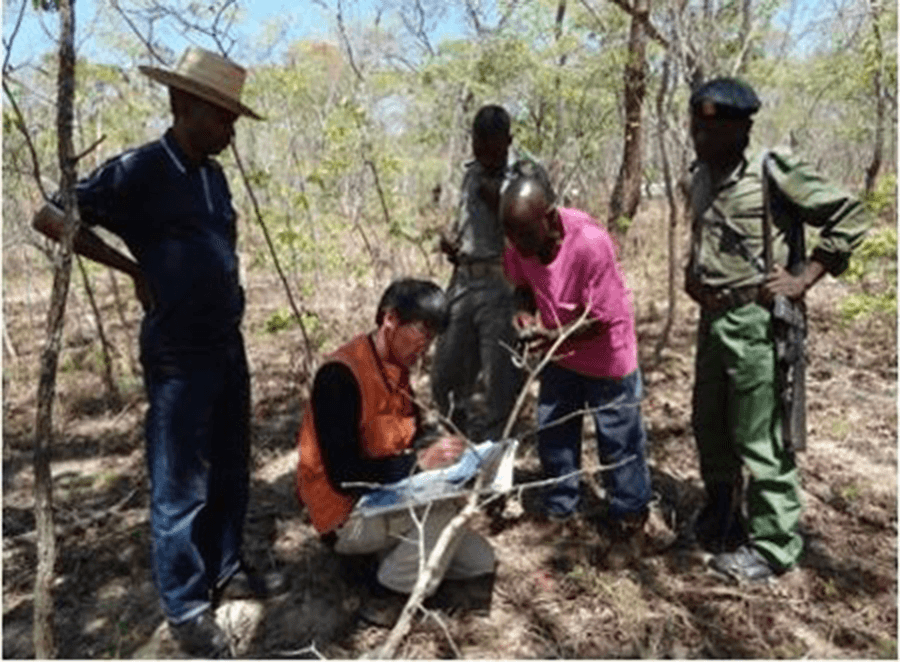
Traditional forest inventory techniques require a lot of field work. Workarounds exist but at the expense of accuracy. Here, field work for forest inventory in Malawi (Photo: Asia Air Survey)

Instead, we are introducing an automated inventory technique that utilizes airborne laser scanning in order to improve accuracy and reduce field work.
Airborne laser is a technology for measuring the shape of the terrain, buildings, forests, etc. by mounting a laser scanner on a plane or helicopter. Asia Air Survey is developing a method to evaluate forest resources using this technology. Information on the color tone of the vegetation, canopy shape, and tree height is obtained by scanning forests from above. By repeating this every few years, it is possible to measure the growth of each individual tree and hence to calculate its carbon accumulation. Outside Japan, the carbon balance of forests is generally estimated by multiplying the variation of forest area by the unit carbon amount of each tree species or forest type, but by using laser data, more accurate carbon assessment can be achieved, which can result in higher quality credits.
Display the document


HEMIX™ bioplastics utilizing wastes from agriculture, forestry and fisheries
We reduce CO2 emissions by creating bioplastics from unused or discarded materials such as trees and marine products.
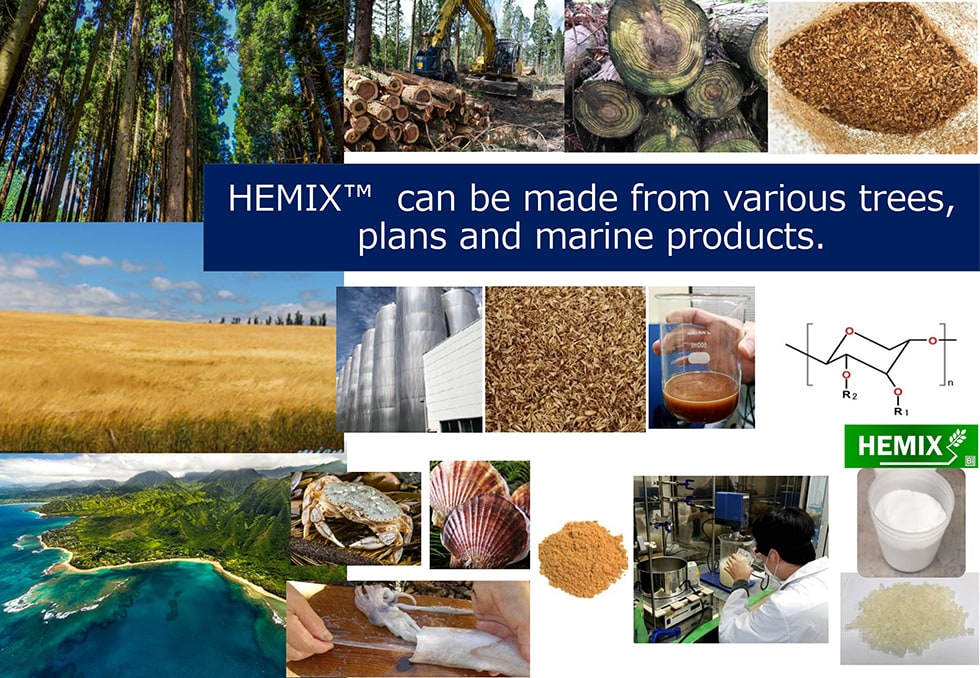
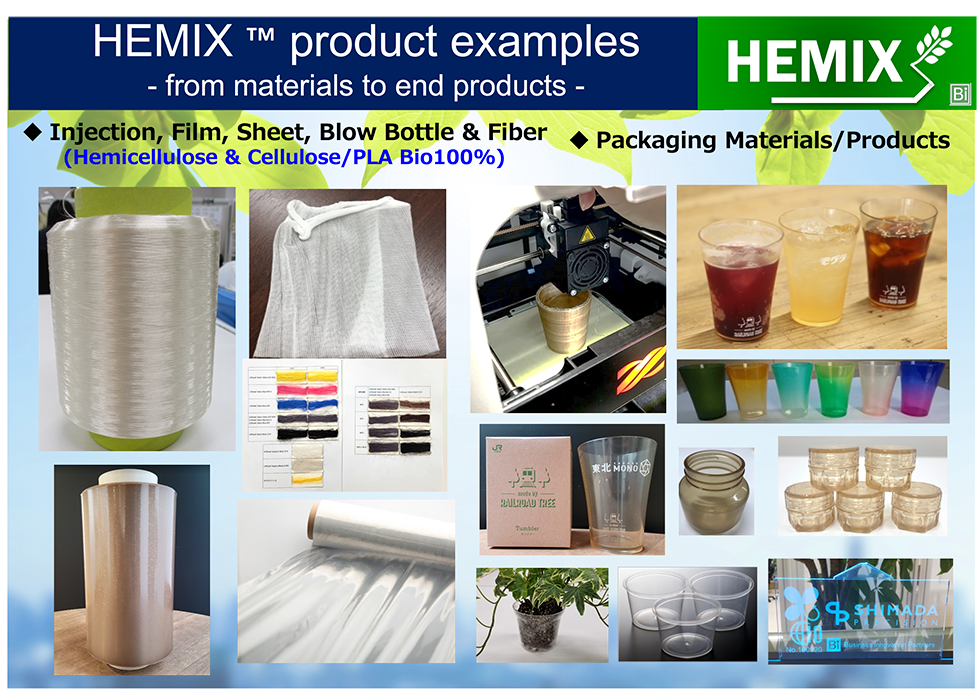
We are promoting the practical application of "HEMIX™, a biodegradable bioplastic developed using hemicellulose which is a component contained in trees and plants in general and has excellent biodegradability, liquidity and transparency, by making full use of our proprietary extraction, chemical synthesis, and mixing technologies.
Resin can be developed from cedar, hinoki cypress, barley, coffee grounds, tea leaves residuals, squirt, etc., in cooperation with various business entities in the agriculture, forestry and fishery industries that aim to utilize trees, plants, and marine products that have not been used, discarded or incinerated.
This is a technological development that contributes to the reduction of CO2 emissions toward the realization of a zero-carbon society by 2050.
Display the document

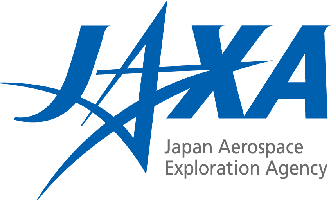
JAXA's effort on Climate Change monitoring by Satellites
JAXA is operating satellites and enhancing Earth observation research for contributing to tackling Climate Change.
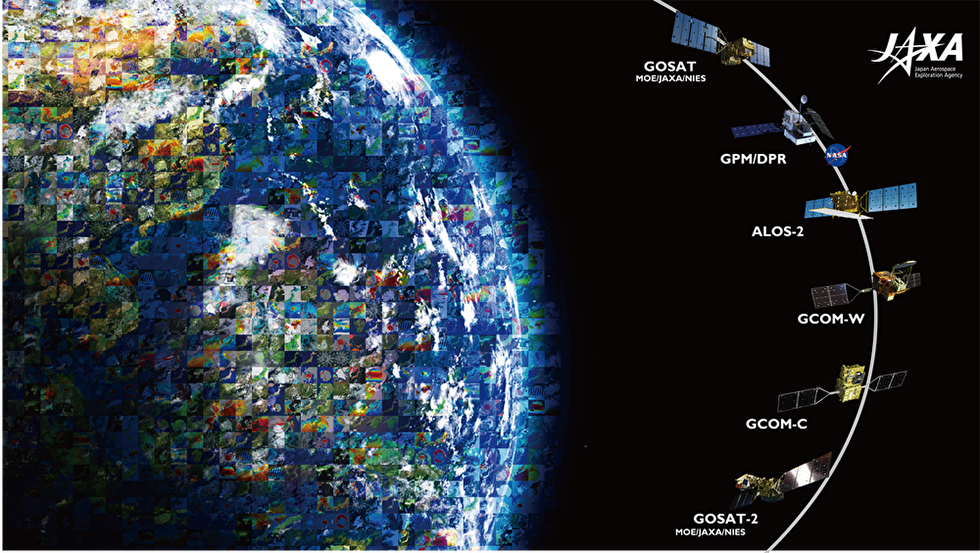
Figure1. Japanese Earth Observation satellites in Operation
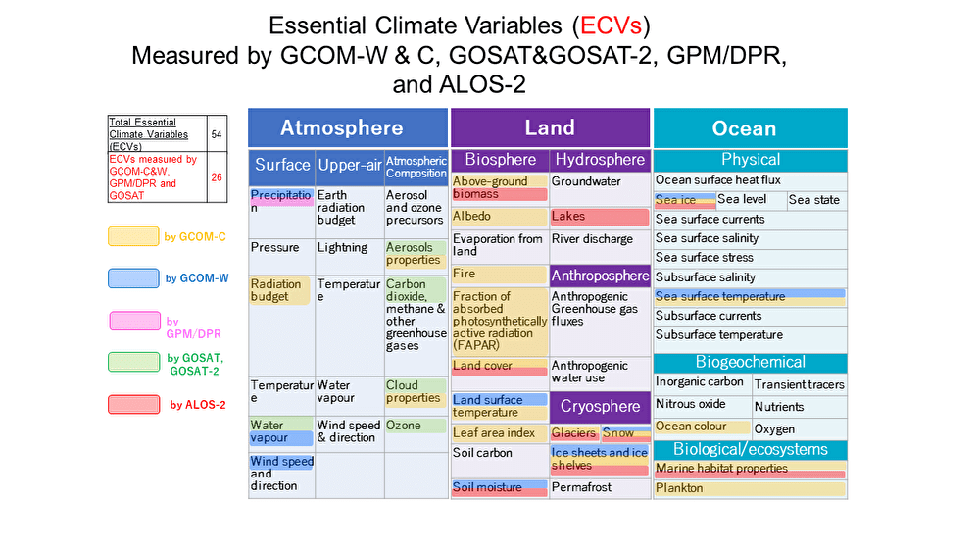
Figure 2: Contribution of JAXA’s Earth Observation Satellites to GCOS ECVs
JAXA, the Japanese core agency to develop satellites, is operating 6 satellites and developing various earth observation satellites that observe land, ocean and atmosphere for addressing the global challenges.
The data are publicized with free and open access to enhance people around the world to utilize those for various purposes. To understand the status of climate change, it is necessary to observe effective geophysical parameters globally with optimal spatial and timescales. Essential Climate Variables(ECVs) were specified internationally to identify and predict specific changes in the global environment caused by climate change. Currently, JAXA’s Earth observation satellites contribute to 26 ECVs, and the long-term satellite observation data is used in several reports including IPCC.


Strategy towards sustainable and zero-carbon society in developing countries
JICA's climate change strategy focuses on Implementation of the Paris Agreement & Actions for Development Co-Benefits.
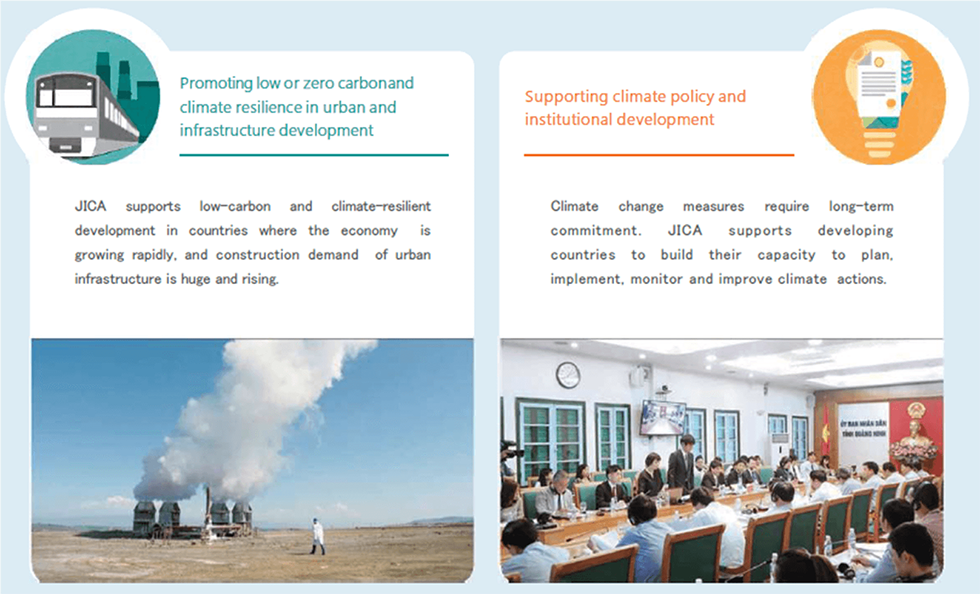
Priorities under the Global Agenda (zero-carbon and climate resilient urban and infrastructure development, Climate policy and institutional development)
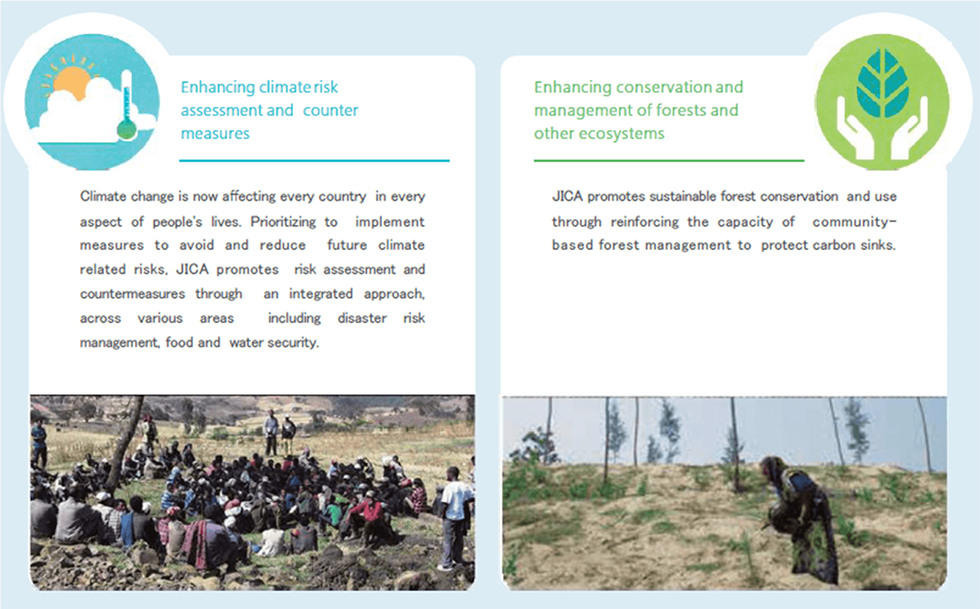
Priorities under the Global Agenda (Enhancing adaptation and risk financing based on climate risk assessment, Conservation and management of forests and other ecosystems)
JICA has over 100 offices in developing countries and provides Japan's ODA through technical cooperation, finance and investment, and grants. In June 2021, JICA developed “Global Agenda” as a strategy towards the zero-carbon and climate-resilient society with 2 pillars:
1.Enhance countries’ capacity for formulation and implementation of NDC, transparency framework and Long-term low emission development strategy for the Implementation of the Paris Agreement
2. Promote co-benefits of achieving the SDGs and taking climate actions such as:
- Zero-carbon and climate-resilient urban and infrastructure development
- Enhancing adaptation and risk financing based on climate risk assessment
- Conservation and management of forests and other ecosystems for GHG emission reduction and carbon sinks
Display the document


Innovative Peatland Management by Ground Monitoring and Earth Observation with AI
Maximizing the natural capital of tropical peatlands through scientific knowledge & technologies to tackle climate changes
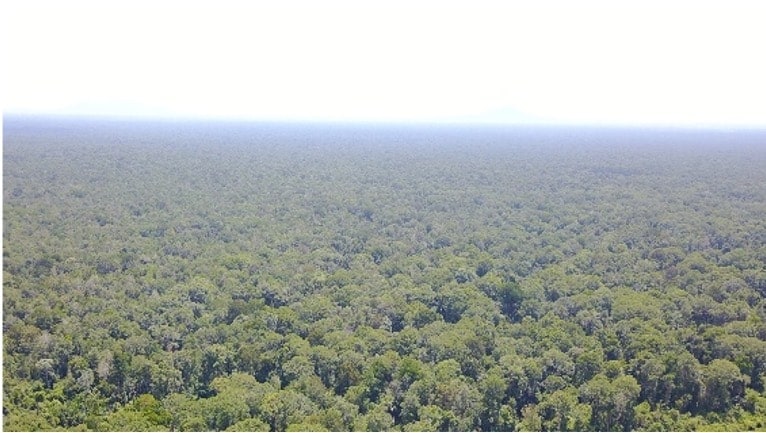
Protected tropical peatlands in Indonesia under Sumitomo Forestry management
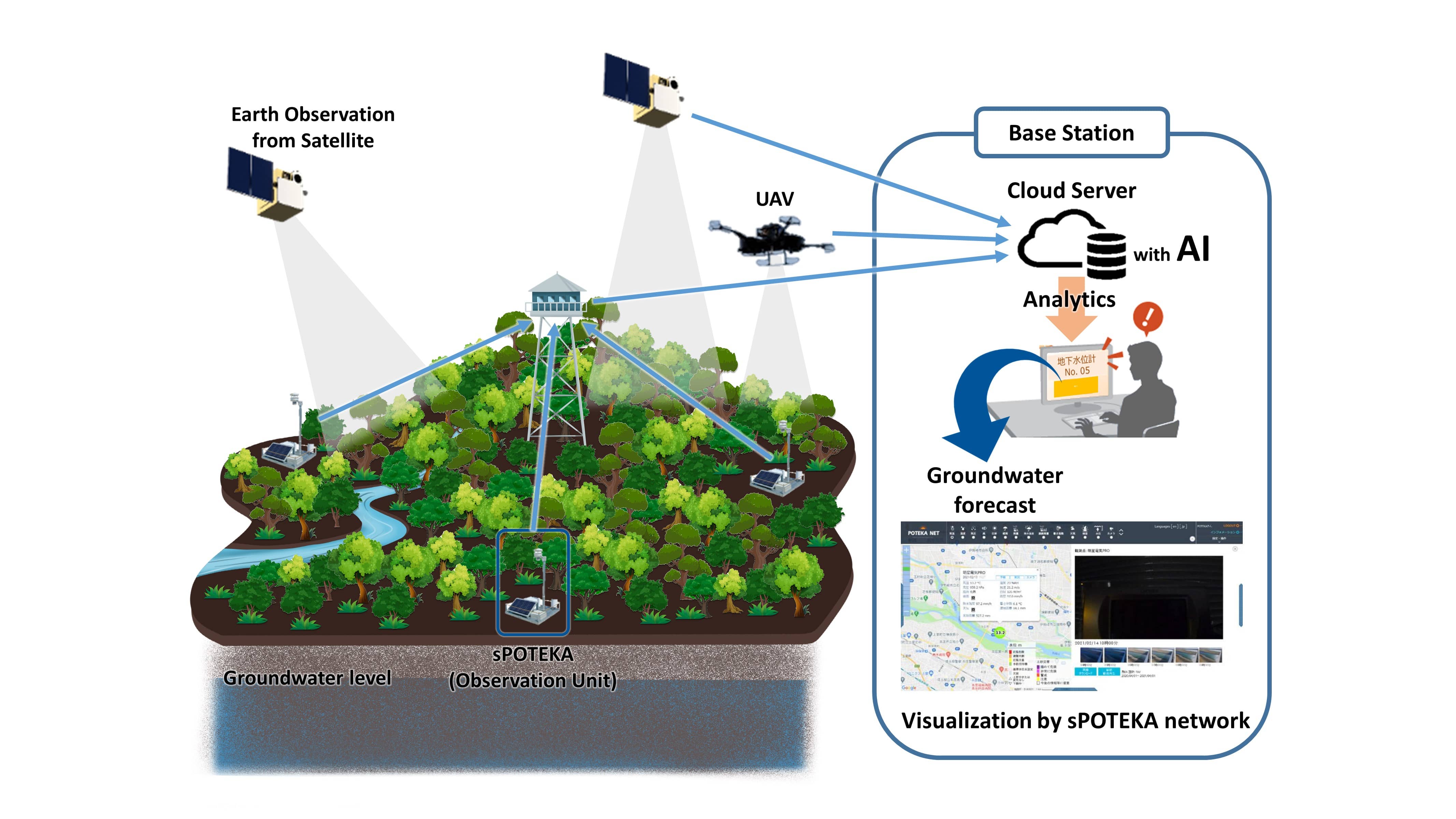
Monitoring concept by weather and earth observation technologies
Tropical peatlands store vast amount of carbon and sustain global water cycle and biodiversity. However, overexploitation/fires have released 2.2 to 3.7 billion t-CO2/yr. This is equivalent to 6 to 11% of global emissions. Sumitomo Forestry (SFC) has realized sustainable forestry in Indonesia based on scientific knowledge; developed a management model preventing peatland from drying out and collected data over 10 years. SFC and IHI have teamed up to bring this sustainable model to the world, which tackle global climate changes by monitoring on ground and earth observation with AI. Ministry of Economy, Trade and Industry (METI) supports our development through promoting utilization of satellite data, such as HISUI, ASTER, PALSAR. We are planning to launch constellation of satellites in equatorial orbit to improve these observation technologies.
Display the document


Effective uses of rice husks with a technology from Hiroshima
Contribution to actual CO₂ zero emissions by converting unused rice husks as waste into carbon-neutral biomass fuel
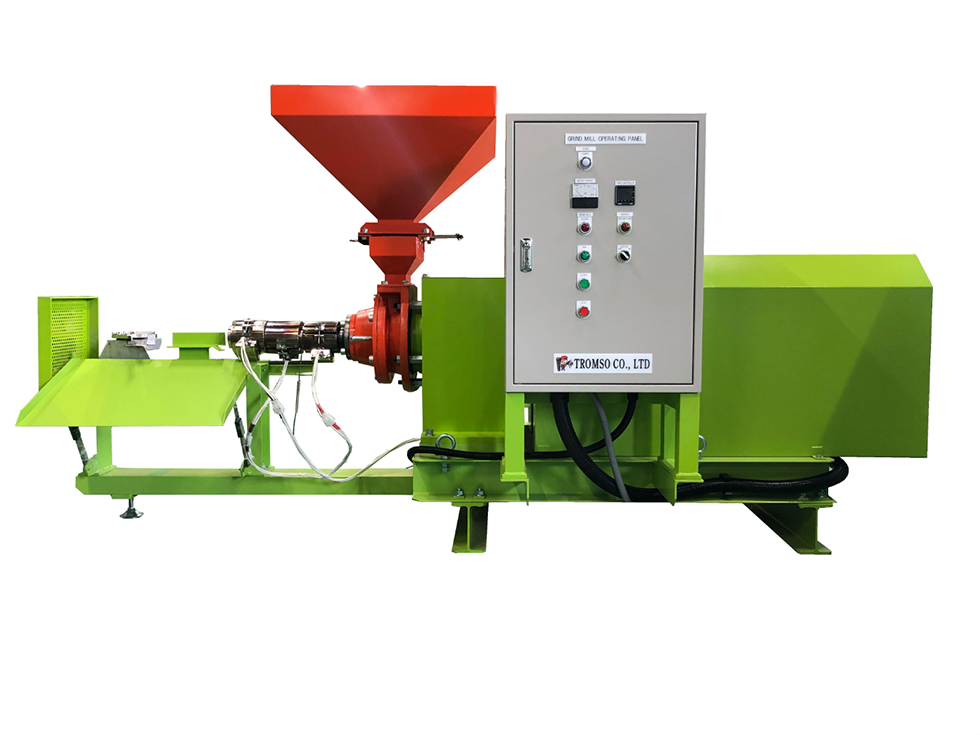
Rice husks briquetting machine(Grind Mill)
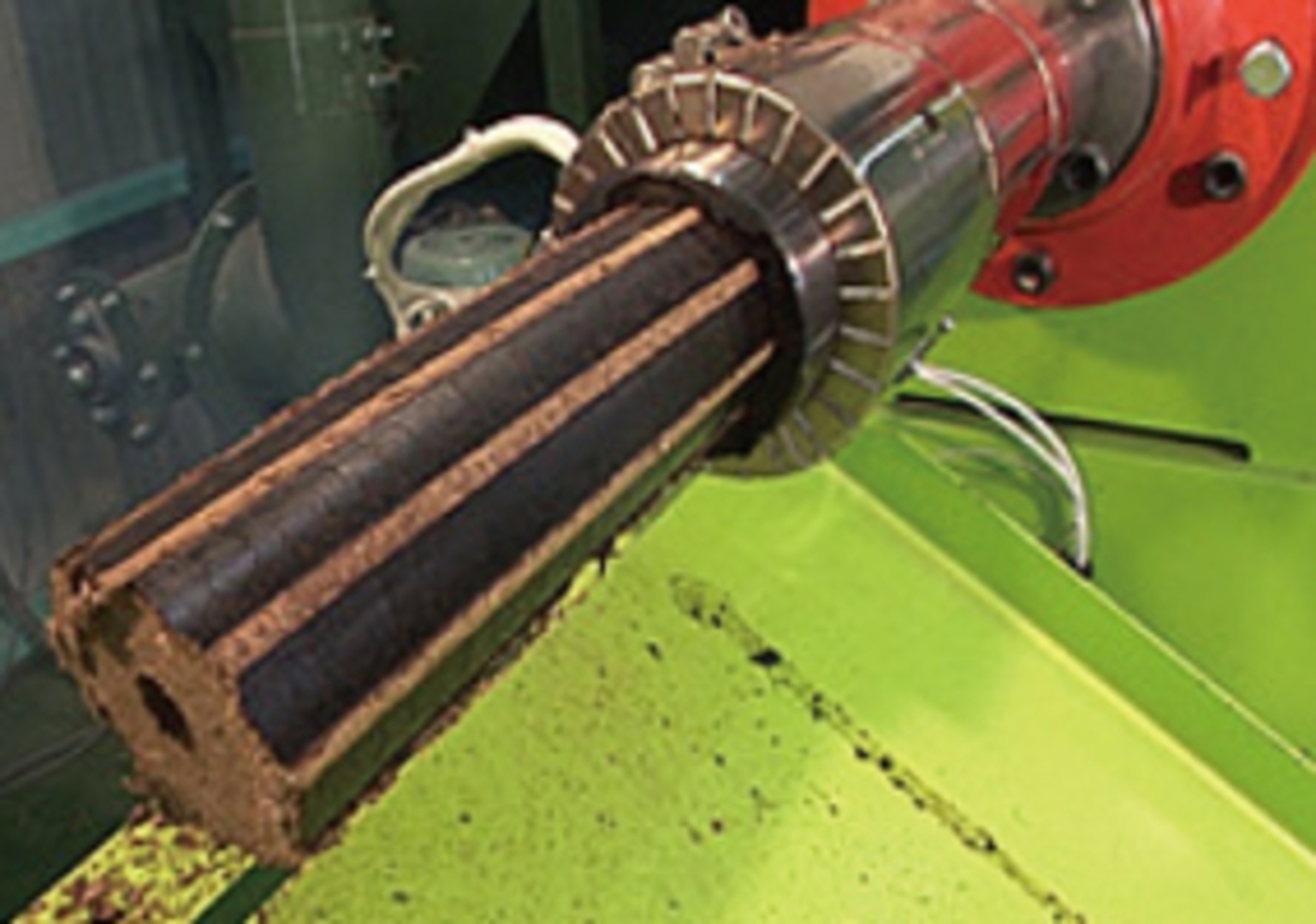
Rice husks briquettes (Momigalite)
Tromso Co., Ltd. is based on ship-building industry technology in Hiroshima, Japan. Rice husks briquette machine (Grind Mill) uses underutilized rice husks to produce briquette fuels called "Momigalite". It can be used in place of firewood or charcoal, boosting forest preservation efforts.
It has been adopted as a "City-to-City Collaboration for Zero Carbon Society" by the MOEJ and is working on a survey of the CO2 reduction effect of Grind Mill since 2019.
7 units of Grind Mill were introduced in Nigeria as a "Non-Project Grant Aid" by the MOFA in 2019, and about 30 units of Grind Mill have been introduced in Africa region so far. It prevents serious deforestation and contributes to solve environmental problems by utilizing a rice husks as an alternative fuel to firewood and charcoal.
Display the document


Green Slow Mobility
Small mobility services using electric low-speed vehicles
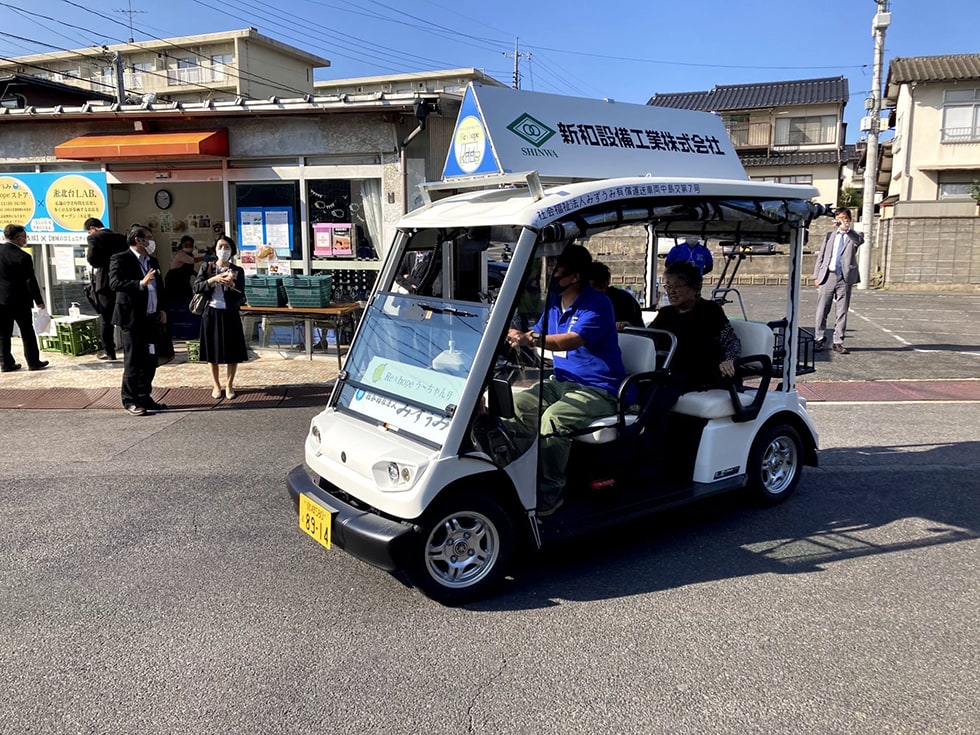
Transporting rural residents (Matsue)
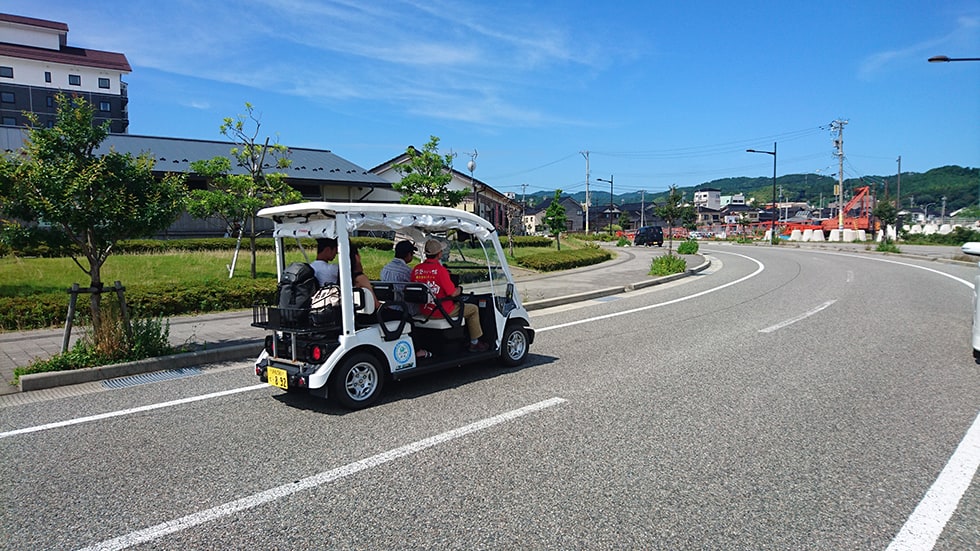
Mobility for tourists (Wajima)
The waning of public transport in provincial areas of Japan has produced a greater environmental impact as the result of growing use of personally-owned vehicles and created mobility problems for senior citizens unable to drive.
Green Slow Mobility have little environmental impact and can coexist harmoniously with pedestrians and cars due to their low maximum speed of under 20km/h. Hopes are high for the potential these vehicles have to address environmental impact and reduced senior mobility problems when used for living activities within communities and as a means of transport in tourist destinations, helping achieve an even lower carbon society.
Since 2018, efforts have been made to increase the promotion of Green Slow Mobility through national verification experiments, vehicle purchasing subsidies, etc. in Japan. The Eco-Mo Foundation continues to lend its experimental vehicles, to hold training sessions, and to share its operational know-how.
In this presentation, we will explain the concept of Green Slow Mobility, vehicle and regional initiatives, etc.
Display the document


Hitachi is Becoming a Climate Change Innovator to Realize a Decarbonized Society
Hitachi is a Principal Partner of COP26 to show strong commitment to the realization of global efforts to decarbonize.
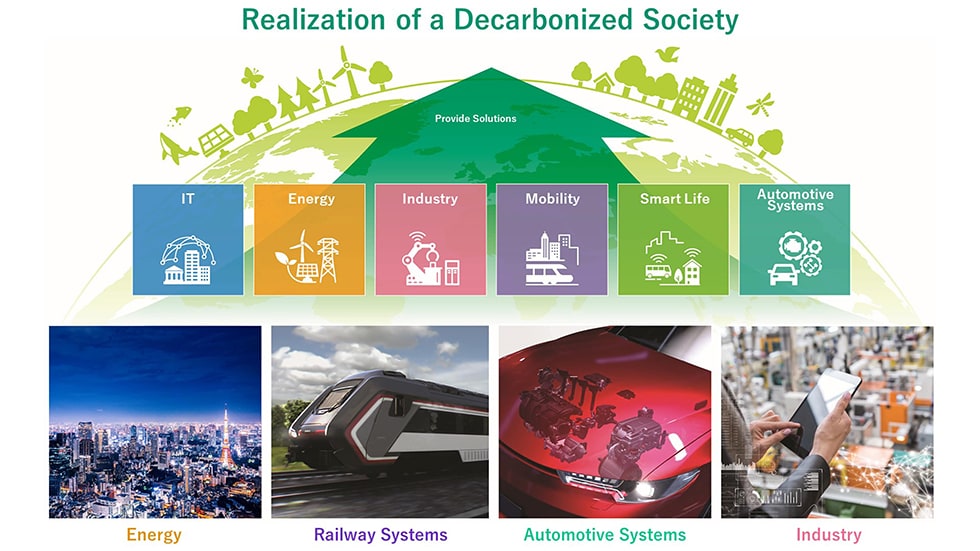
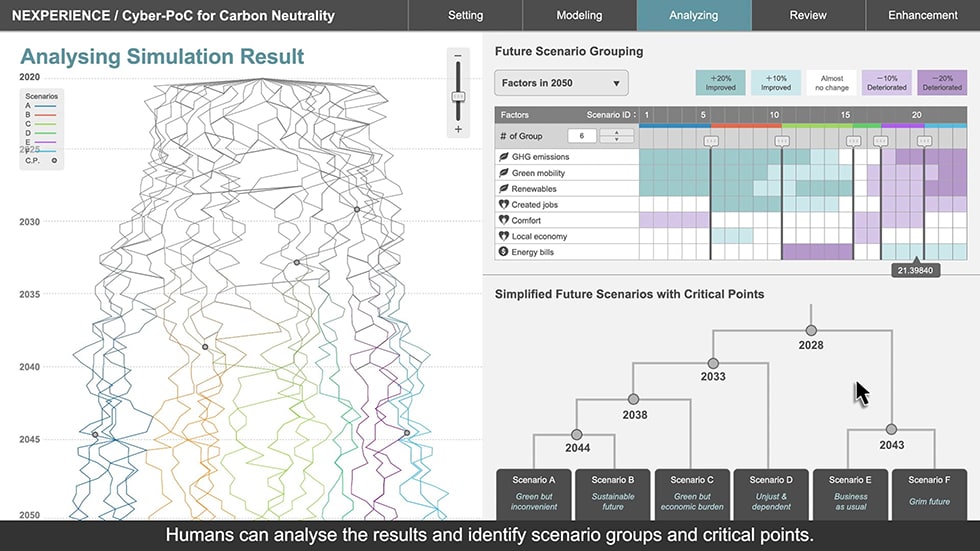
Future scenarios and critical points simulated by AI based on various parameters
Hitachi strives to improve people's quality of life and contributes to achieving a sustainable society through the Social Innovation Business that creates new value for society by offering a combination of the OT (operational technology), IT and products.
We are accelerating our efforts to achieve carbon neutrality within Hitachi by FY2030 and across the company's entire value chain by FY2050. Hitachi's green technologies and digital innovations help governments, cities and companies cut their greenhouse gas emissions, and contribute to solving challenges in the area of climate change.
In addition, we work on the development of AI simulator showing future scenarios and critical points to promote fruitful discussion on future policy roadmap among various stakeholders for carbon neutrality.
Display the document


Carbon Negative Concrete "CO²-SUICOM"
"CO²-SUICOM" is a technology that absorbs and permanently stores carbon dioxide during the hardening process of concrete.
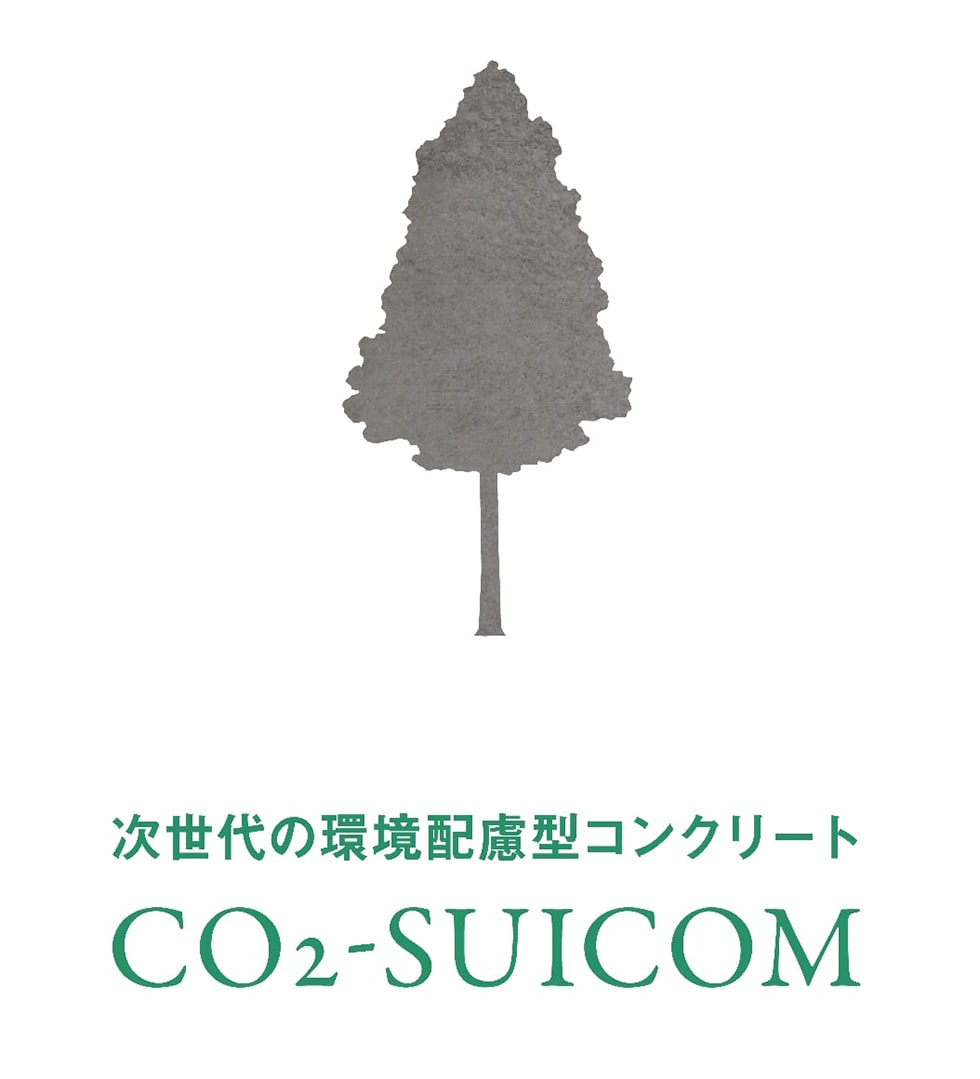
CO²-SUICOM is a technology that can contribute to the reduction of CO² emissions of more than about 300 kg/m³ during the production of concrete.CO²-SUICOM can (1) drastically reduce CO² emissions during cement production by replacing more than half of the cement with special admixtures made from industrial waste or other raw materials with zero CO² emissions (reduction: approx. 200 kg/m³), and (2) a large amount of CO² is absorbed and fixed in the concrete by curing the concrte in a highly concentrated CO² environment (absorption amount: approx. 100 kg/m³). According to various research organizations (McKinsey, etc.), concrete absorption and fixation technology for minerals, including CO²-SUICOM, is expected to contribute to the reduction of billions of tons of CO² by 2030, which has the potential to exceed Japan's national emissions.
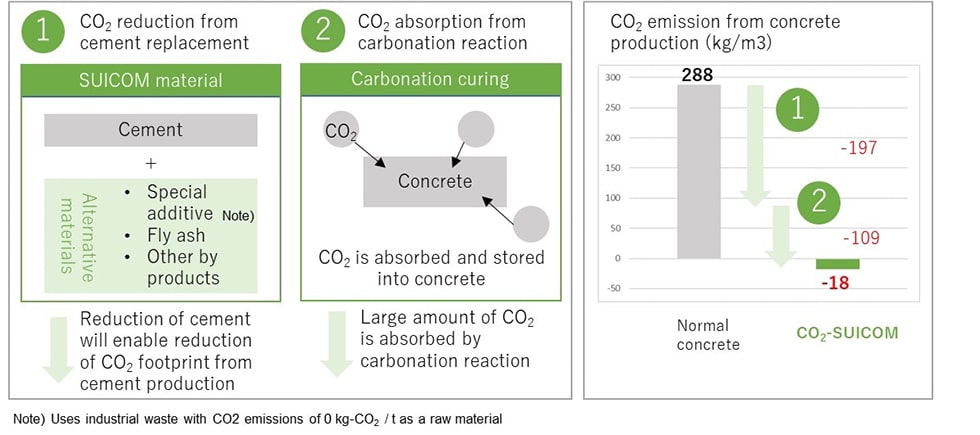
CO²-SUICOM is the world's first commercialized carbon negative concrete technology.
In Japan, it is already used for construction of highways and paved roads, etc., and we are now promoting commercialization overseas. In order to decarbonize our society, The Chugoku Electric Power Company, Kajima Corporation, Denka Corporation and Landes Corporation has developed the technology, and Mitsubishi Corporation is in charge of commercialization overseas.
A CO²-SUICOM concrete block can reduce CO² emissions equivalent to what a cedar tree can absorb in a year. This is a break thorugh technology for concrete which is one of the most consumed materials in the world.With the power of CO²-SUICOM we aim to realize a sustainalble society by decarbonizing the global infrastructure.
Display the document

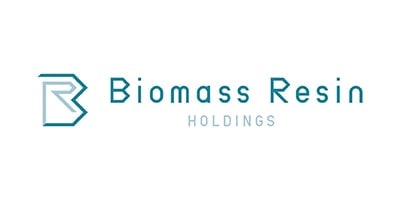
Rice Plastic Innovation by non-edible rice as a new resource as Biomass Plastic from Japan.
"Rice Resin" Biomass Plastic could mix up to 70% with rice to reduce the petroleum resources and cut a significant amount of CO2.

Rice Resin

Rice Resin products in the Market
Biomass plastic “Rice Resin"" derived from rice (non-edible rice). Excess rice that is not treated as feed, such as old rice, crushed rice, and crushed rice that is not edible, is upcycled into plastic. Rice can be mixed up to 70%, greatly reducing the content of petroleum-based plastics. “Rice Resin” is originally made from plants on the earth, it has the property of ""carbon neutral"" that does not affect the increase or decrease of CO2 on the ground, and is eco-friendly with almost the same cost, moldability, and strength as conventional plastics. It is used in a wide range of applications, from garbage bags, cutlery such as spoons and cups, amenities such as toothbrushes and combs, to toys.Furthermore, we are developing biodegradable plastics with the aim of launching in 2022.
Display the document


Our mission: Challenge of developing new refrigerants and solvents with low GWP
The AMOLEA™ Series of environmentally-friendly refrigerants and solvents
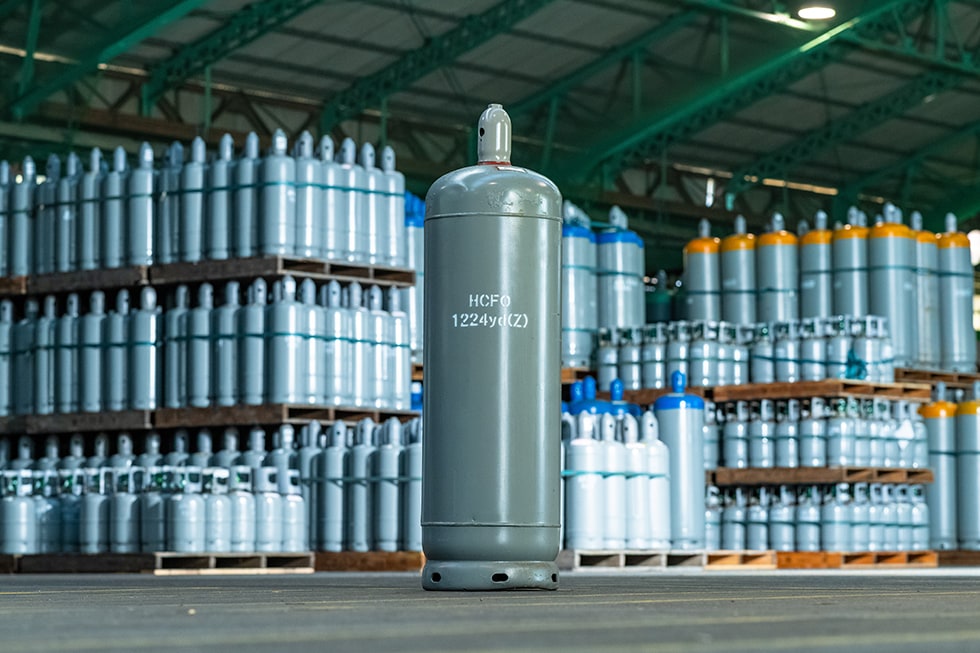
AMOLEATM 1224yd is a non-flammable refrigerant that consists of HFO-1224yd(Z), designed for use in centrifugal chillers, binary cycle generators and waste heat recovery heat pumps, blowing agent, aerosol solvent, and cleaning solvent. With Ozone Depleting Potential (ODP) of almost zero and a GWP value under 1, AMOLEATM has little impact on the natural environment.
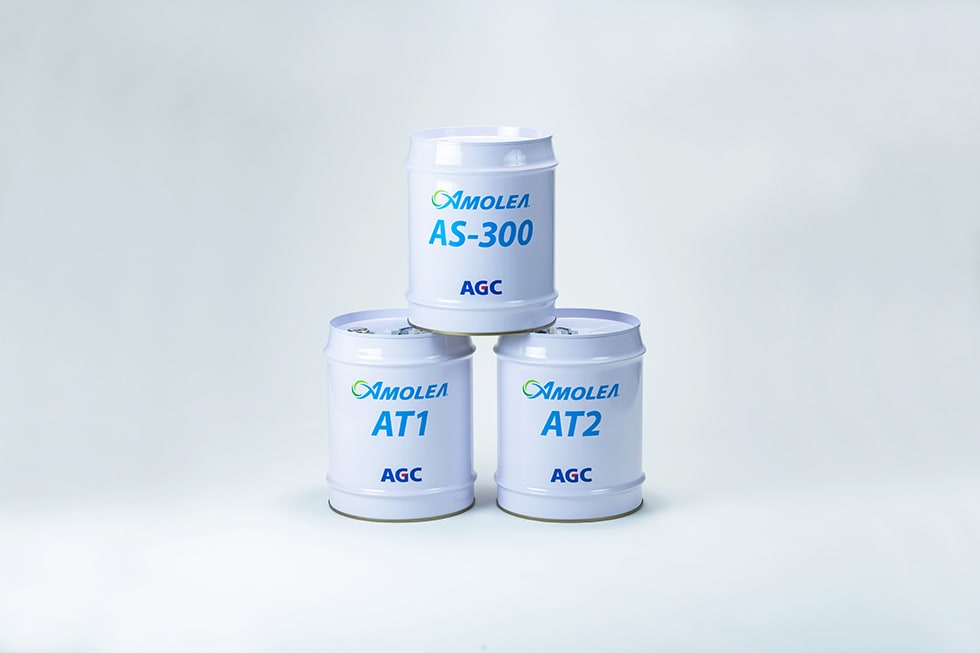
AMOLEA™ AS-300 is a next-generation, fluorinated, non-flammable solvent with low environmental impact and maximum cleaning power. Its Ozone Depleting Potential (ODP) is nearly zero as well as Global Warming Potential (GWP) is less than 1, which can be an alternatives for flammable solvents, n-PB and offered in vorious applications such as pitch & wax cleaning, silicone oils dilution, PU dissolution so on.
AGC Chemicals has dedicated itself to the vision of “Chemistry for a Blue Planet.” In line with that vision, we are focusing on research and development targeted toward the creation of products that will contribute to the reduction of greenhouse gas emissions. The progress that we have made in one area of technology has resulted in the creation of the AMOLEA™ Series of environmentally-friendly hydrofluoroolefins (HFOs), including air conditioning refrigerants and cleaning solvents. A key advantage of AMOLEA™ refrigerants and cleaning solvents is a global warming potential (GWP) hundreds of times lower than that of earlier products. This innovative technology is attracting attention as a solution to the climate change problem.
Display the document

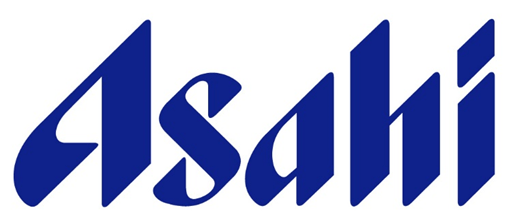
Development of SOFC Power Generation using Methane Gas from Wastewater Treatment
We successfully generated 200kW of electricity using fuel cell with purified methane gas from wastewater of our Brewery.

Plant over view

Schematic Block Flow Diagram
Biomethane gas is a byproduct of anaerobic wastewater treatment process of our Brewery and is burned with fossil fuels to produce the thermal energy needed for brewing processes. We decided to use fuel cells in order to reduce CO2 emissions with biomethane gas. The poisonous substances contained in the biomethane gas inactivate the fuel cell electrodes. We developed a system that can stably remove poisonous substances in biomethane gas. Succeeded in continuous stable power generation for more than 10,000 hours at the laboratory. Based on these results, we designed, fabricated, and operated a biomethane gas purification plant to operate a 200kW fuel cell, and obtained good results. Based on these results, a 200kW solid oxide fuel cell (SOFC) was installed and successfully generated.
Display the document

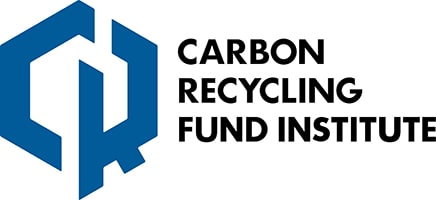
Creating “Sustainable Carbon Society” by CO2 Utilization and Carbon Recycling
We achieve a virtuous cycle of the environment and economy through promoting carbon recycling and creating innovation.
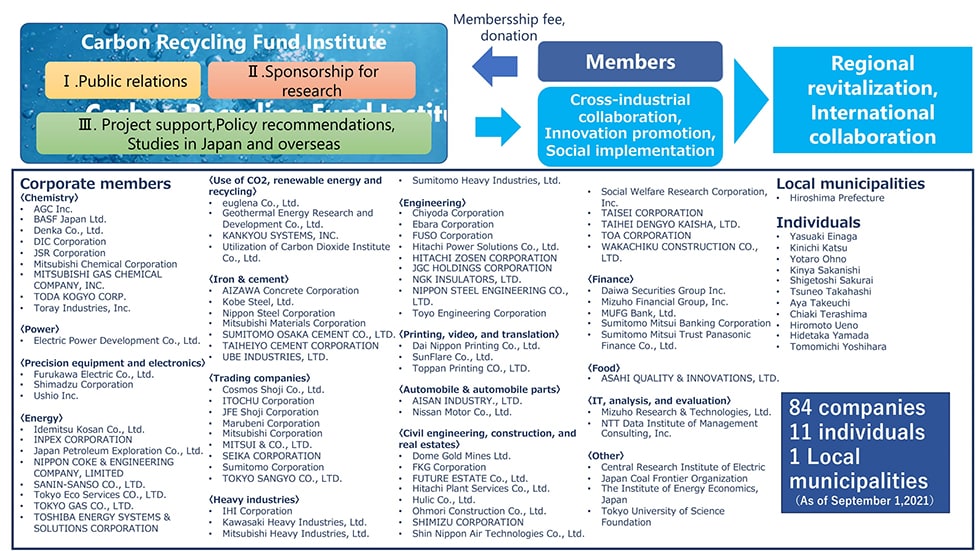
Business scheme and member list
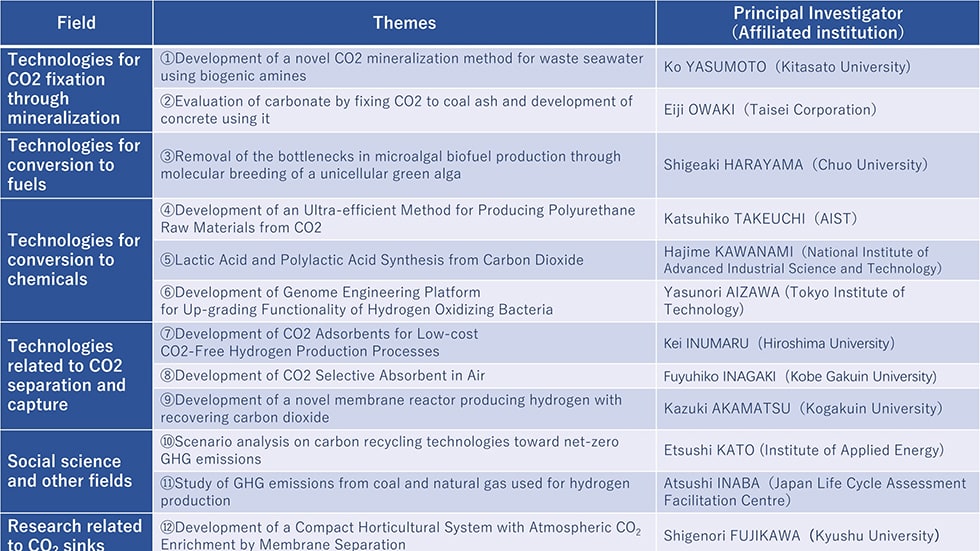
A list of studies adopted in 2021
Aiming simultaneously to solve problems with global warming and energy access, we support the activities of various companies and individuals working on implementation of carbon recycling with membership fees and donations from our members as the source.
We provide public relations, grants to researchers, support for members' business, and policy recommendations on carbon recycling.
Members are composed of a wide range of industries such as chemistry, energy, construction, finance, and trading companies. Taking advantage of the characteristics of cross-industry organizations, we strive to promote open innovation and contribute to regional revitalization and international cooperation.
The research grant activities support basic research with excellent originality and innovation in carbon recycling by uncovering ideas and researchers buried in companies, universities and other organizations, and also support applications for national projects and social implementation as the next step.
Display the document


Industrial waste treatment emitting less GHG, and recycled fuel saving fossil fuels
Upper:Recycling treatment, Lower:Recycled fuel
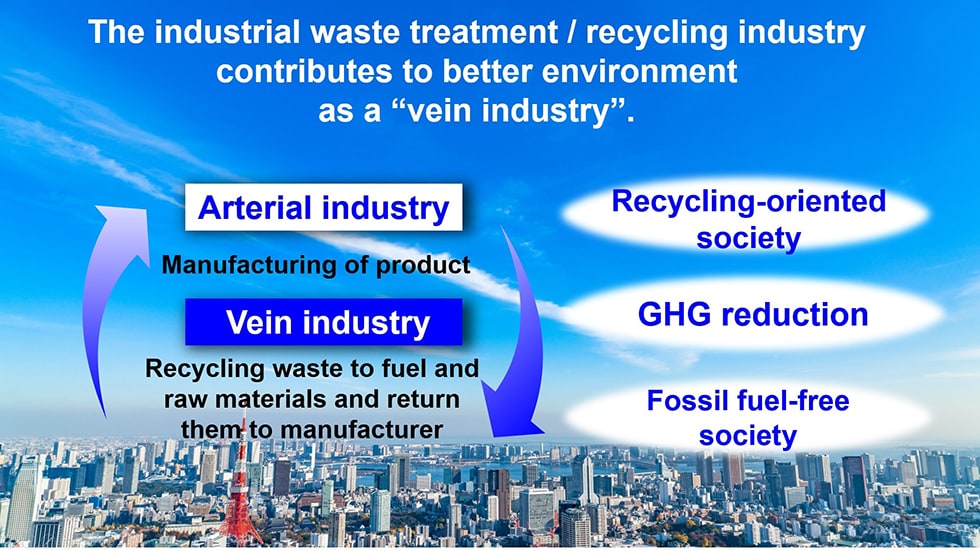
Role of recycling and industrial waste treatment industry
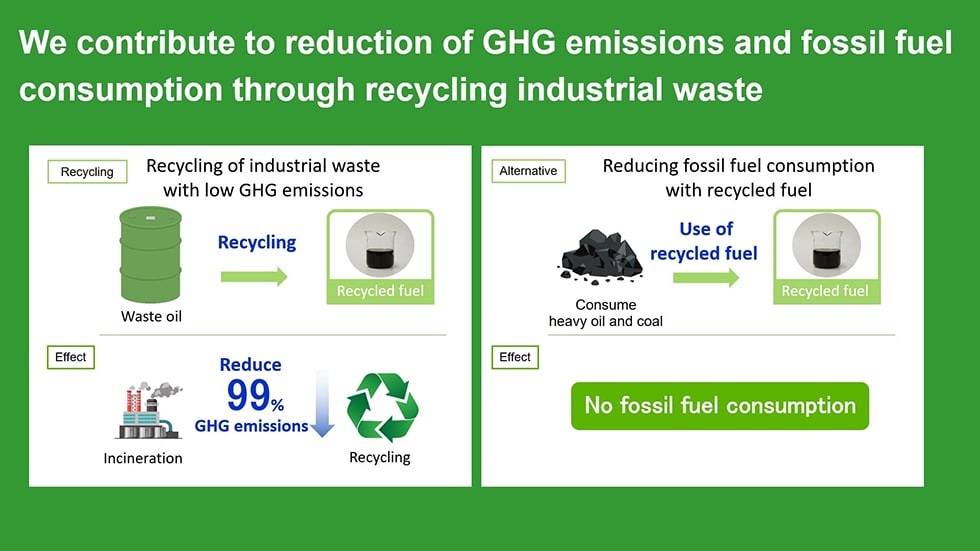
Reducing of GHG emissions and fossil fuel consumption through recycling industrial waste
The recycling and industrial waste treatment industry is called the “vein industry”. This is like a vein that has the function of returning blood sent from the heart through the arteries to the heart. We are responsible for recycling and returning resource to manufacturer. The “vein industry” contributes to recycling-oriented society, GHG reduction,and fossil fuel-free society.
Our recycling treatments emits less GHG than simple incineration does. In FY2021, we calculated the amount of GHG emissions during making waste oil and solvent into recycled fuel decreased by 99% compared with the GHG emissions during incineration. In addition,substituting coal for recycled fuel reduces fossil fuel consumption.
Display the document


Realize Carbon Neutral Society by Methanation Technology (HiMethz)
Realize Carbon Neutral Society by methane production by H2 and CO2 in exhaust gas from Waste to Energy plants.
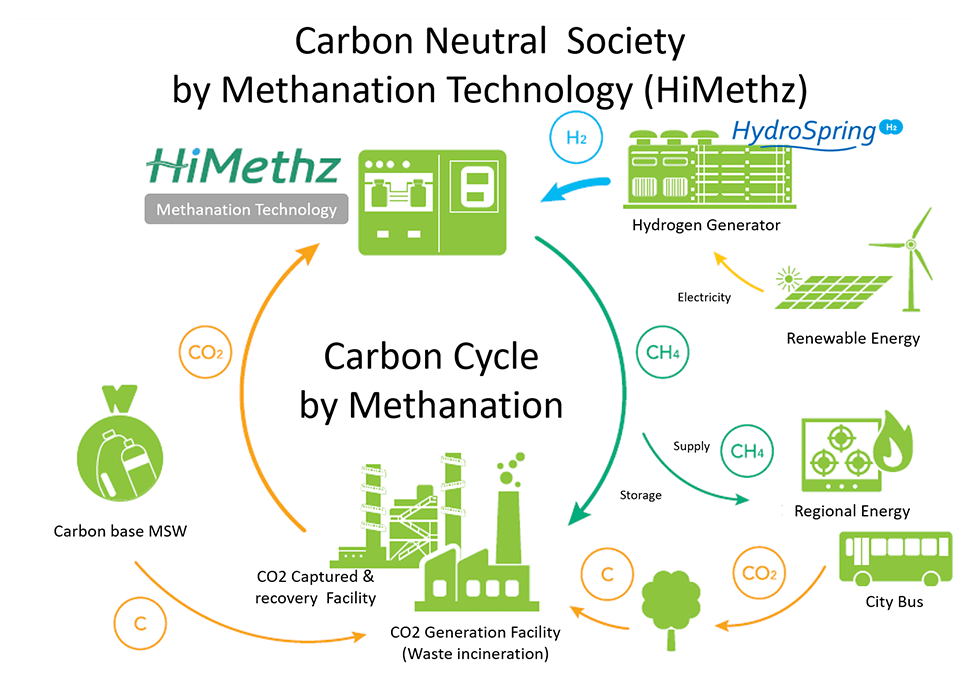
Promotion of Carbon Neutral Society
Hitachi Zosen Corp has researched & developed metanation technology for >25 years, which produces CH4 by reacting CO2 with H2.
Our unique high-performance methanation catalyst is highly evaluated by research institutions.Produced CH4 is possible to be transported, stored & utilzed in existing NG infrastructure since its main componets is NG.
It is possible to utilized CH4 as local energy produced by our methnation technolgoy with CO2 captured from exhaust gas and H2 produced by water electrolysis with surplus renewable energy in Waste to Energy plants.
In addition, CO2 generated by combustion of CH4 is recovered and converted to methane again to realize carbon cycle utilization. It is expected to spread in the future toward the realization of Carbon Neutral Society in 2050
Display the document


Tomakomai CCS Demonstration Project
Achieved the target of 300,000 tonnes cumulative CO₂ injection in 2019.
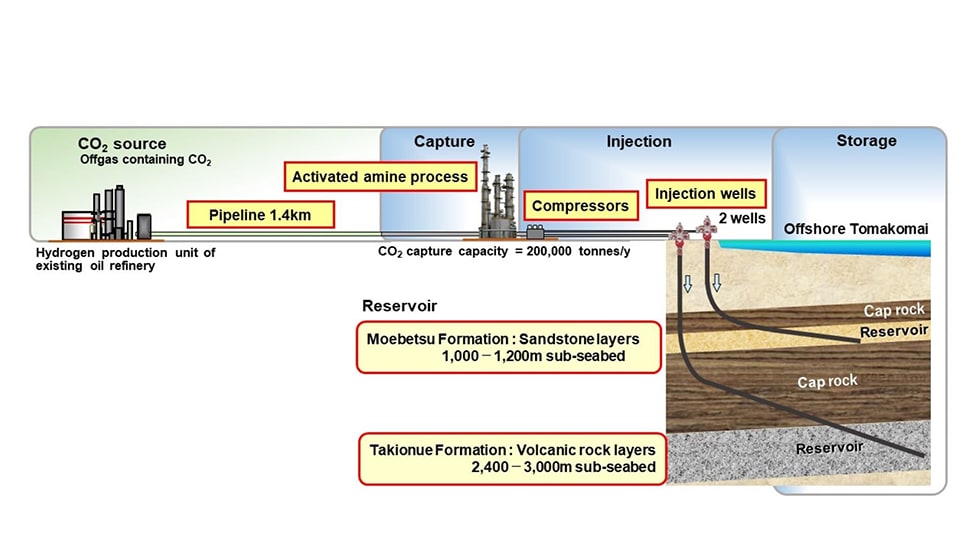
Project overview
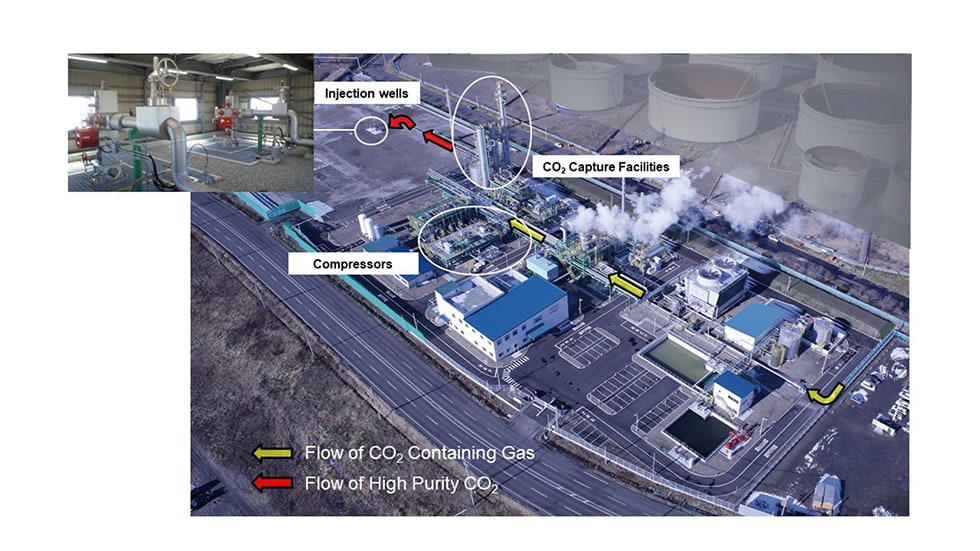
Tomakomai CCS Demonstration Project
The Tomakomai CCS Demonstration Project, Japan’s first large scale CCS demonstration project is being conducted by the Ministry of Economy, Trade and Industry, New Energy and Industrial Technology Development Organization, and Japan CCS Co., Ltd. The facilities were constructed from FY2012 to 2015, injection at 100,000 tonnes/yr started in April 2016, and the initial target of 300,000 tonnes cumulative injection was achieved on November 22, 2019.
Gas containing CO₂ from a refinery is transported by pipeline to the capture facilities, and the CO₂ is compressed and stored 3-4km offshore in two sub-seabed reservoirs by two directional wells.
The project confirmed the safety and security of CCS through the operation of an integrated CCS system from capture to storage.
Display the document


CO₂ Separation and Recovery Technology HiPACT® / DDR-Type Zeolite membrane
Contribute to decarbonization by chemical absorption (HiPACT®) / membrane separation (DDR-Type Zeolite membrane) !
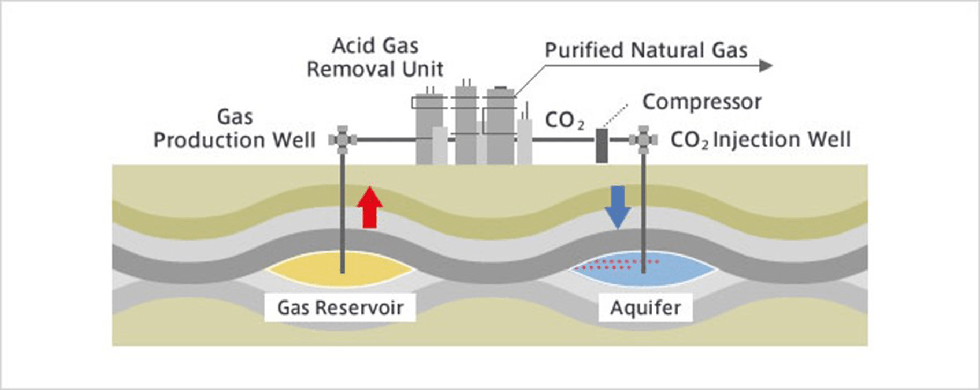
Illustration of the CO₂ Capture, Utilization, and Storage (CCUS) Scheme
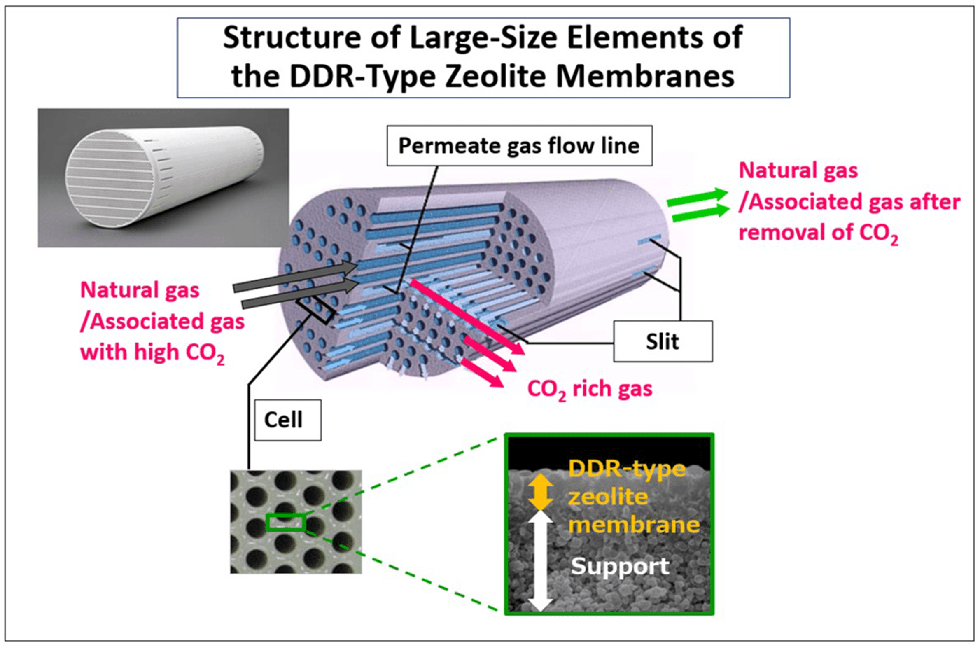
DDR-Type Zeolite membrane
Amid the global efforts toward decarbonization, there is a growing need to reduce the environmental impact of fossil fuel production. Therefore, efficient CO₂ capture, utilization, and storage technology (CCUS) is crucial. JGC contributes to decarbonization by providing high efficiency & energy saving solutions in CCUS, using HiPACT® / DDR-Type Zeolite membrane.
HiPACT® is a chemical absorption process. CO₂ is recovered from natural gas and synthesis gas at high pressures. Its high stability against thermal degradation and superior CO₂ absorption performance enable a reduction of 25 to 35 percent in CO₂ recovery and compression costs.
DDR-Type Zeolite membrane has high selectivity and high pressure / high CO₂ concentration durability, which enables a reduction in CO₂ recovery costs.
Display the document


Chemical recycling technology enabling a circular economy of plastic waste
JGC provides 3 chemical recycling technologies: Monomerization, Pyrolysis, and Gasification, accommodating the plastic waste impurities.
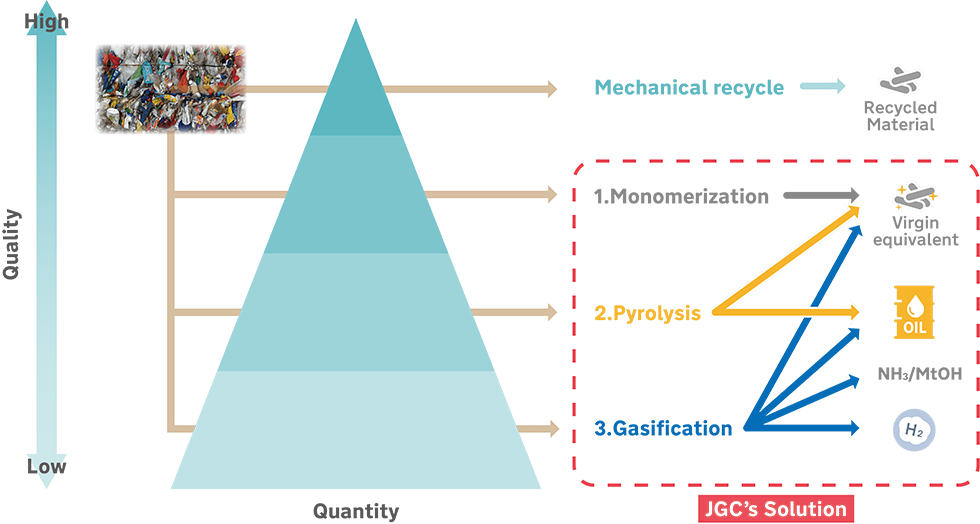
Technology line-up for plastic waste recycling

Total solution for plastic in a circular economy
Monomerization: The DMT method has an advantage in removing dyes and impurities in raw materials. It is an effective method to recycle clothing polyester and cascade recycled PET products that are not suitable for material recycling. The method has an operation track record on a commercial scale and solves the mass clothing waste issue.
Pyrolysis: A technology based on Japan's largest commercial pyrolysis equipment using a catalytic pyrolysis method. Pyrolysis oil is supplied to refineries and chemical plants to realize chemical recycling. It also enables the processing of PVC / PET mixed plastic.
Gasification: EUP gasifies plastic waste by partial oxidation to produce syngas that can be used to synthesize chemicals such as ammonia and olefins. It holds the world's only long-term commercial operation record for gasification chemical recycling applications.
Display the document


AMUSE™️ for the Hydrogen Society
The Potential of Ammonia as a Hydrogen Carrier
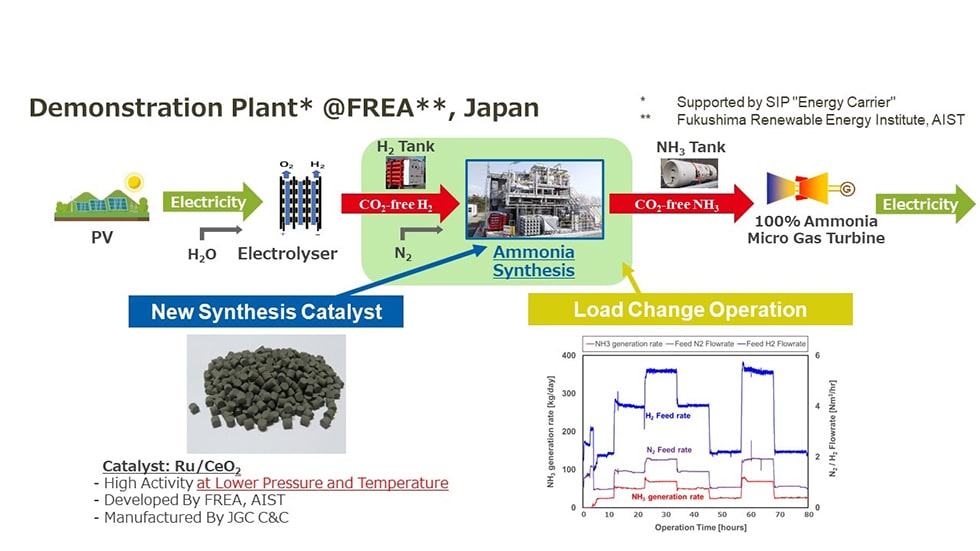
Green Ammonia Value Chain Demonstration
A value chain demonstration that achieved green ammonia production using green hydrogen derived from renewable energy sources (PV) and CO₂-free power generation by ammonia gas turbine.
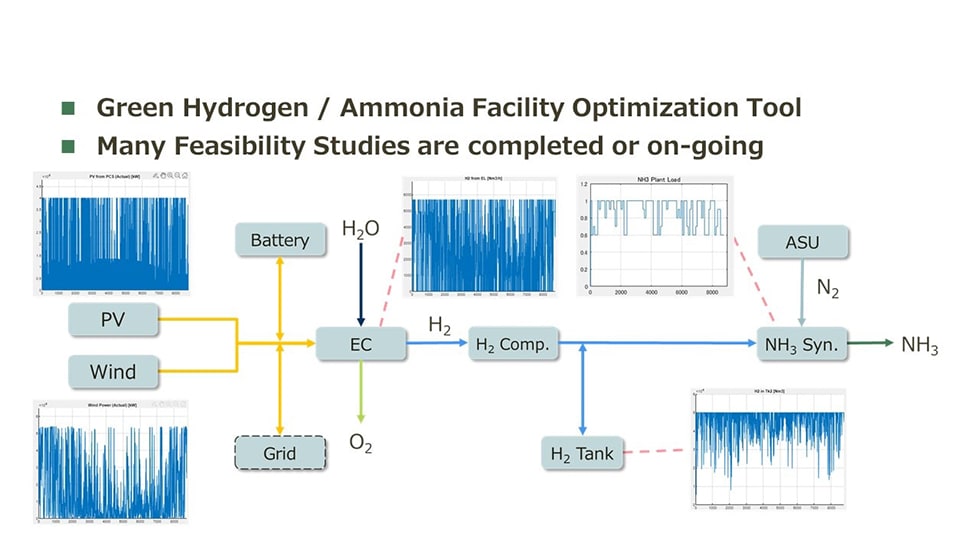
Development of the Green Hydrogen and Ammonia Facility Optimization Tool
Appropriate capacity design is required to accommodate the constantly fluctuating renewable energy. We have developed a plant design optimization tool for renewable energy showing various generation profiles based on the location, season, and type.
As a solution to realize a decarbonized society, the use of hydrogen energy is expected to expand in the future. The JGC Group is capable of handling all three major hydrogen carriers (liquefied hydrogen, liquid organic hydrides, and ammonia) that are expected to be widely used in the future, and particularly has expertise in the use of ammonia as a hydrogen carrier and fuel. We are developing our original solution AMUSE™️, bringing together the technologies from inside and outside of the company, and aiming for the early realization of a hydrogen society.
At this exhibition, we will introduce the world's first successful demonstration project of a green ammonia value chain and the development of the optimal configuration tool that responds to fluctuations in renewable energy.
Display the document


RuleWatcher - Global rule trends visualizing for Climate mitigation
Translating and visualizing information from govs and orgs using AI. A platform to bring knowledge to everyone.
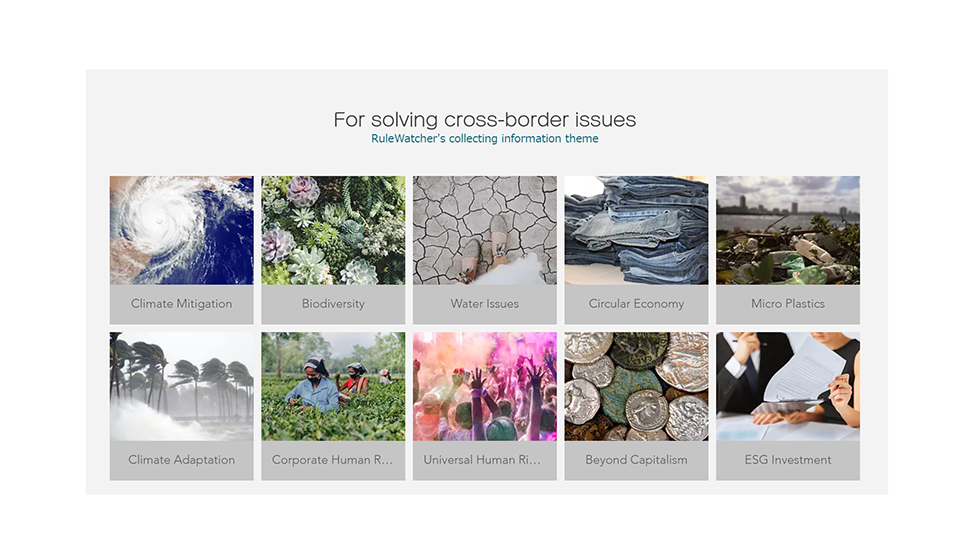
The rules monitored by RuleWatcher are groups of issues that cross national borders. We hope that you will make use of this information in your policy making, project planning, research and civic activities.
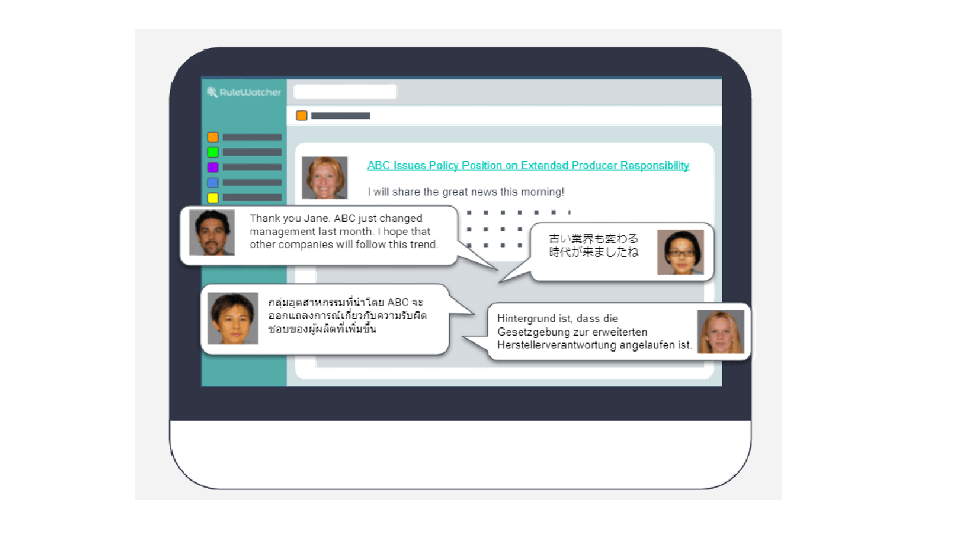
Bringing ideas from different countries to information on the same issue
RuleWatcher® automatically categorizes multilingual information (bills, minutes, press releases, policy recommendations, etc.) from all over the world. As it is Englished and visualised, we can easily grasp them from major parliaments, governments, UNs, research institutes, think tanks, international NGOs, initiatives, evaluation agencies, etc. RuleWatcher sorts them into themes such as "climate change mitigation" and "biodiversity protection" as well. It is a platform that brings together diverse knowledge from all over the world to provide accessible primary information to people around the world who want to solve global issues.
Display the document


Initiatives Aimed at Developing a CO₂ Ecosystem and CO₂ Capture Technology Led by MHI Group
Mitsubishi Heavy Industries (MHI) Group, with the top share of the market in CO₂ capture technology, is actively engaged in developing an overall CO₂ ecosystem.
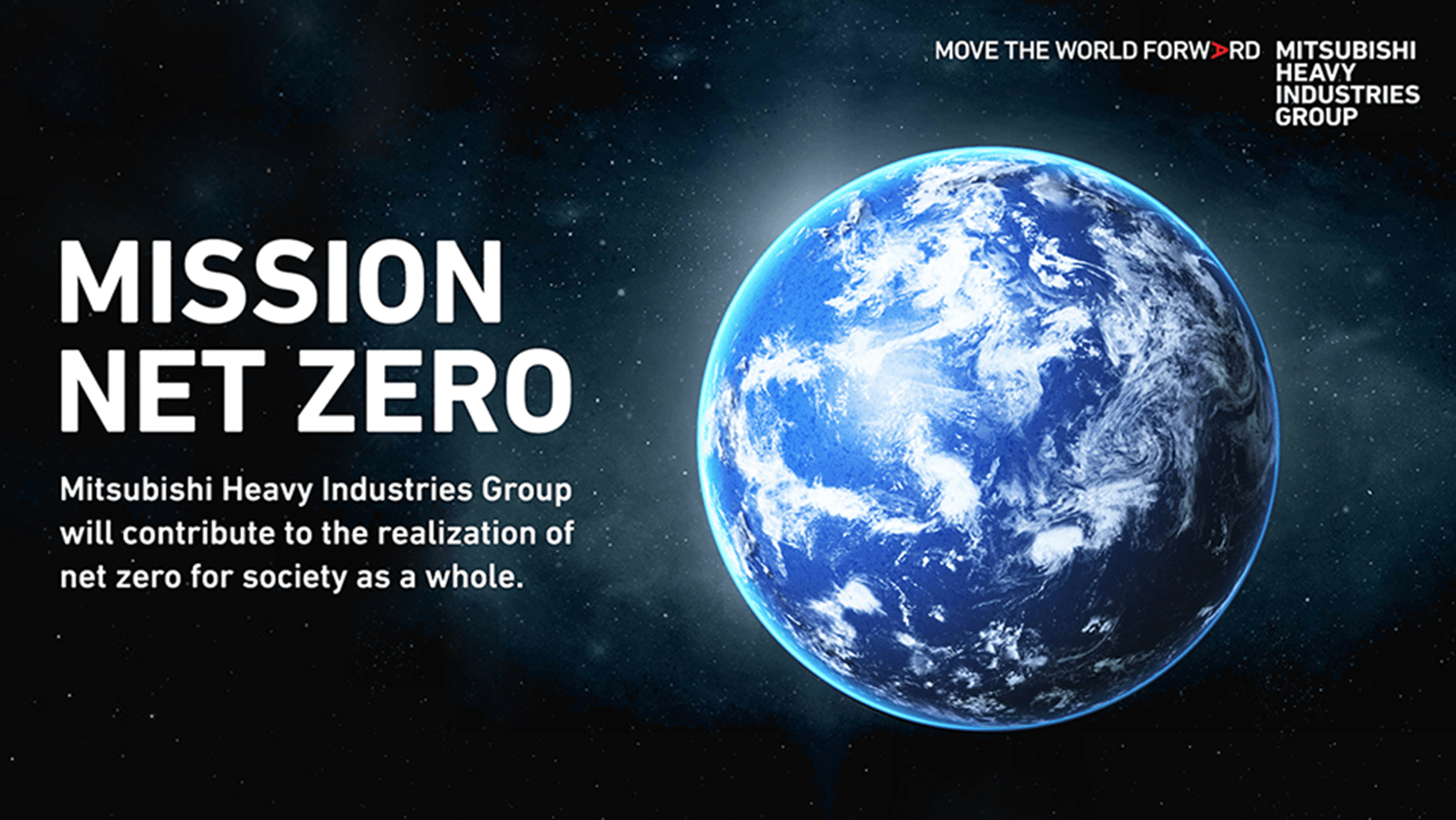
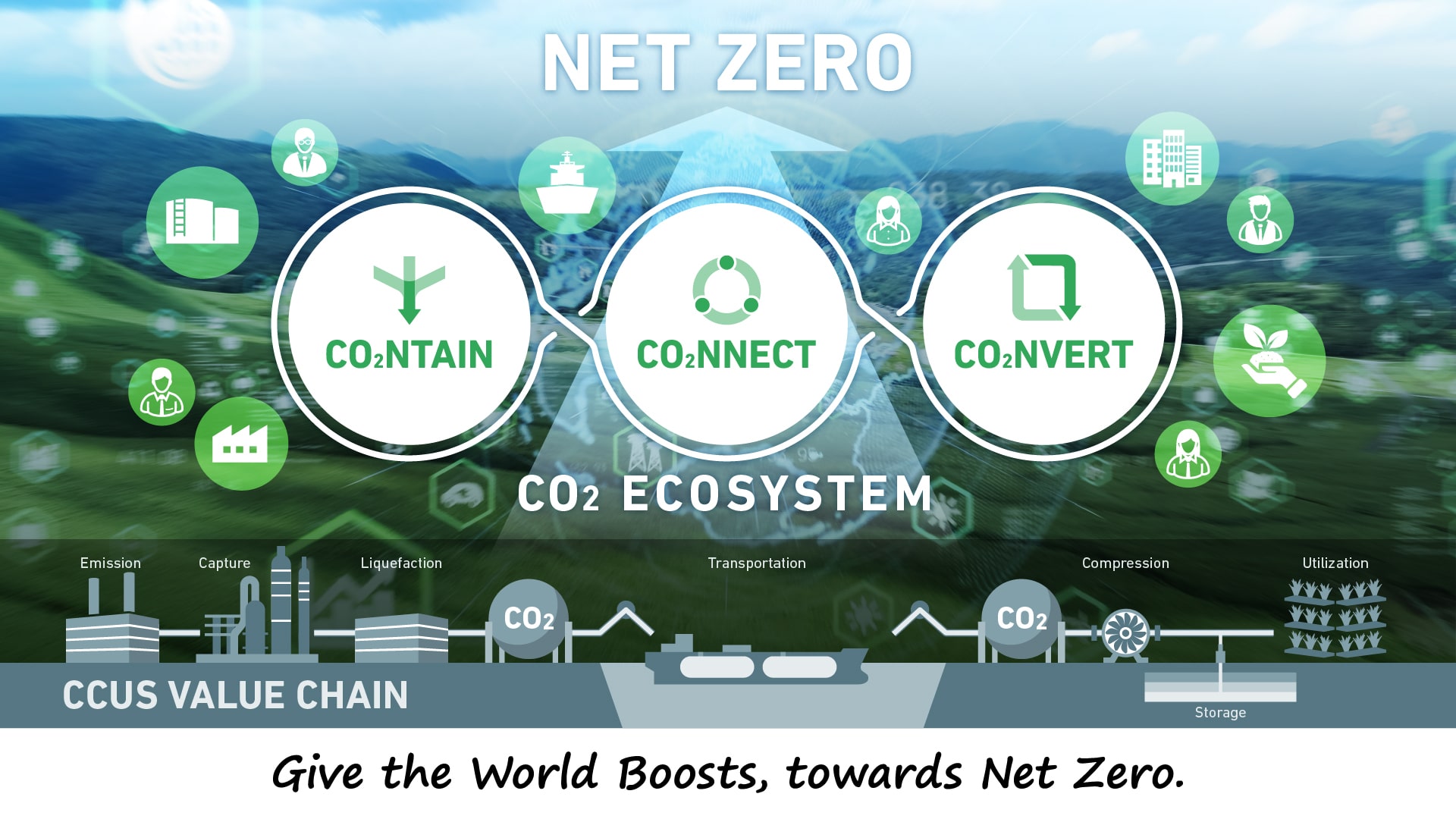
Mitsubishi Heavy Industries (MHI) Group is a leading company in the CCUS value chain, indispensable for achieving carbon neutrality. It holds the top share of the market in technology for capturing CO₂ from post combustion flue gas. MHI’s wide range of technologies, and solutions will contribute to the development of CO₂ ecosystems.
MHI Group focuses on the following three areas in developing the CO₂ ecosystem proactively:
CO₂NTAIN: Capturing CO₂ from a variety of sources
CO₂NNECT: Developing the CCUS value chain
CO₂NVERT: Making effective use of CO₂
At the Japan Pavilion of COP26, a demonstration movie will be shown excellence of MHI Group’s proprietary solvent for absorbing CO₂.
Display the document


Resource Aggregation for Decarbonization “Net-Zero”
Contribute for renewable energy resource as main power supply with a solution to control Distributed Energy Resources
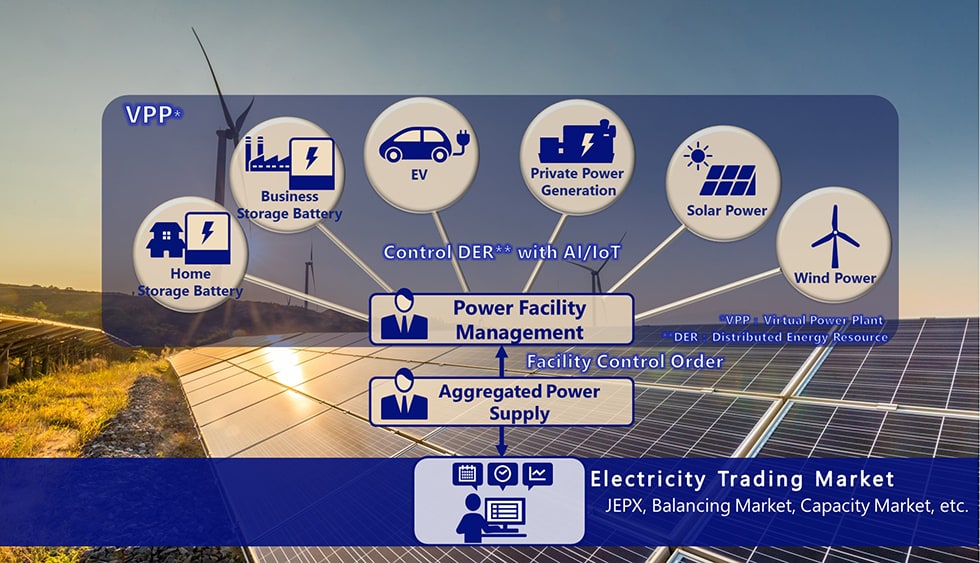
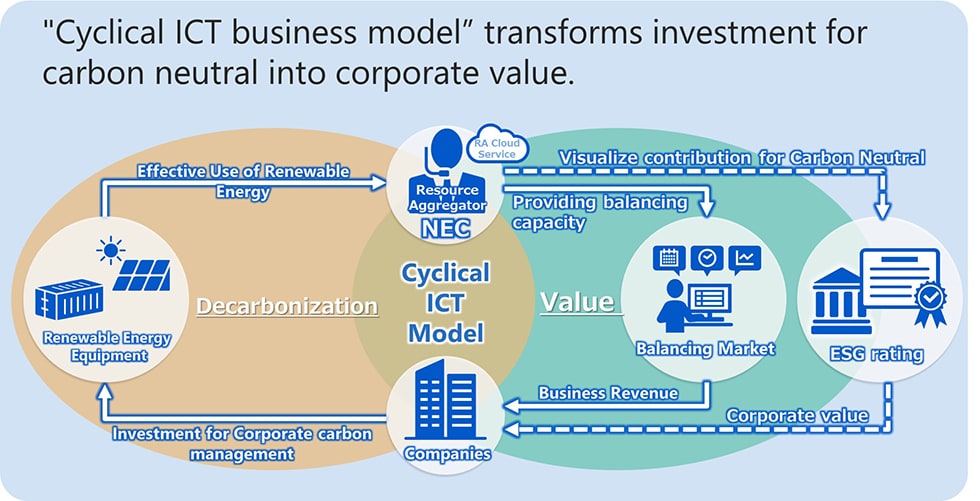
The Balancing Market in Japan was established in 2021 to deal with adjustment capability to balance the fluctuation of power supply and demand, and to maintain the frequency of electric power.The Balancing Market has a key role for renewable energy to be the main power supply.
Since the renewable energy is unstable power supply, balancing capability using AI/IOT to apply Demand Response (DR) on Distributed Energy Resource (DER) is necessary.
"NEC Energy Resource Aggregation (RA) Cloud Service" controls the power demand of DER remotely through VPP* to balance the supply and demand in market within the specific time, according to the DR order from Aggregation Coordinator (AC).
NEC contributes to the “carbon-free” society by reducing Co2 with Resource Aggregation.
*VPP: Virtual Power Plant
Display the document


Redesign the economy and society using hydrogen towards the realization of carbon neutrality.
Use of hydrogen fuel cells are the most suitable solution towards the realization of societies where decentralized energy systems are available.

HARUMI FLAG : Japan’s first full-scale hydrogen infrastructure(original Tokyo2020 Village area)
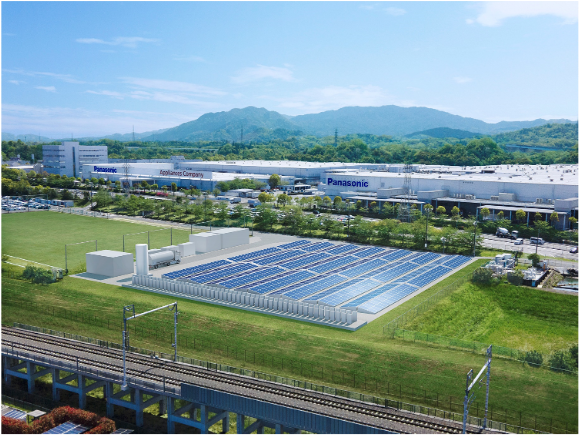
First hydrogen-based plant using only renewable(RE100 solution)
Utilization of renewable energy is a key towards the realization of carbon neutrality. Yet, a means for storing energy to adjust energy supply is required as renewable energies are unstable power source. Thus, we have exhibited a system that can respond to energy demands ranging from a small to a large scale supply using fuel cells where hydrogen is utilized.
We introduce various methods for utilizing hydrogen in our exhibition with Diorama;
1) supply of hydrogen to buildings and housing area through pipelines,
2) transportation of hydrogen to high demand areas for storage and utilization of the stored hydrogen,
3) utilization of the hydrogen generated from chemical factories, etc. as a by-product,
4) decentralized power source; electricity is generated from renewable energies and hydrogen is generated from the electricity for its utilization.
Display the document


New Solar Cells to Boost Renewable Energy
Light, film-type perovskite solar cells and Cu₂O tandem solar cells with high power generation efficiency
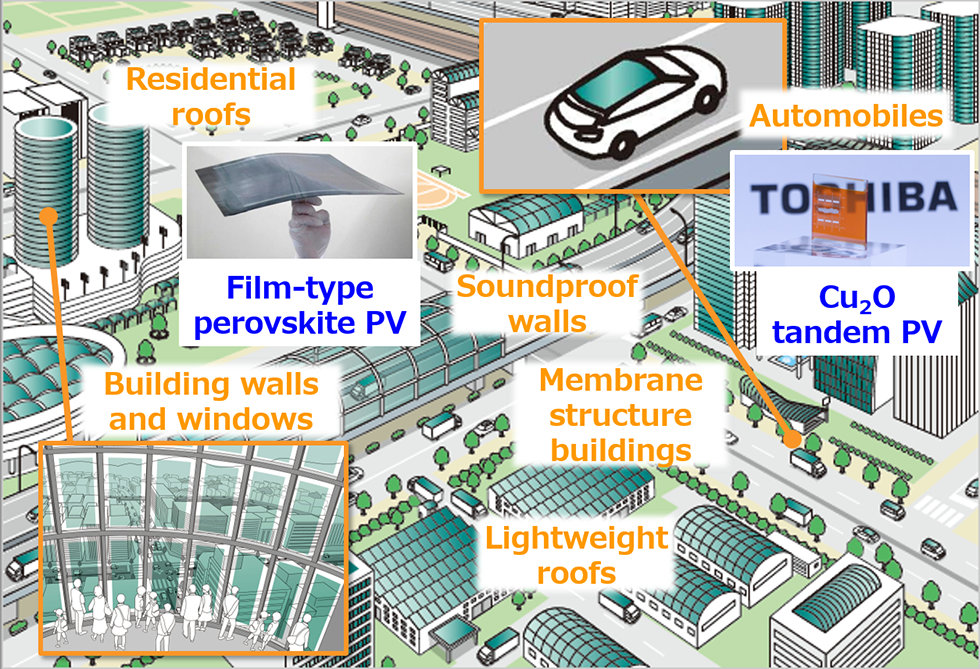
Perovskite cells and tandem cells meet different needs in urban areas
If we are to achieve carbon neutrality, we need to deploy more, and more efficient, photovoltaic power generation. However, current silicon (Si) solar cells are heavy and inflexible, which restricts where they can be installed, and there are limits to how far they can be improved. Two solar cells that Toshiba Group is developing will change this. Film-type perovskite solar cells are light, thin and flexible, and can be installed in buildings and locations inaccessible or unsuitable for Si cells. The Cu₂O tandem solar cell places a transparent copper oxide (Cu₂O) solar cell over a Si solar cell, boosting generation efficiency and producing much more power by area.
Display the document


Achieving circular carbon society using CO₂ capture and Power to Chemicals(P2C)
Our contribution for carbon neutrality by social implementation of CO₂ capture and conversion of CO₂ into valuable products
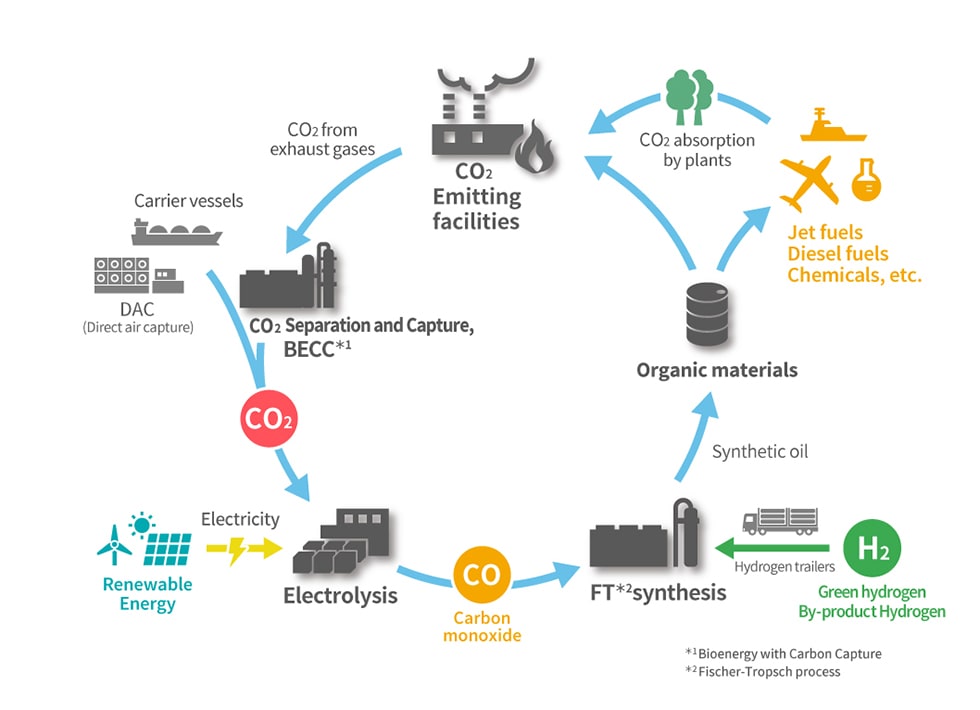
Circular carbon society model through CO₂ Recycling
Toward carbon neutralization where CO₂ reduction is difficult, we provide two technologies; CCUS which captures CO₂ and P2C which produces valuable resources from CO₂. As for CCUS, a pilot plant that captures 10t/day of CO₂ has been in operation since 2009. Based on this knowledge, we constructed the world‘s first large-scale carbon capture plant with BECCS capability that captures 600t/day of CO₂, which is over 50% of the flue gas from the biomass power plant, and started operation in 2020. As for P2C, we are developing a CO₂ electrolyzer which has the world’s highest CO₂→CO conversion rate based on the artificial photosynthesis technology, and studying SAF (Sustainable Aviation Fuel) business model as one of the uses of CO. Both projects are commissioned by Ministry of the Environment.
Display the document

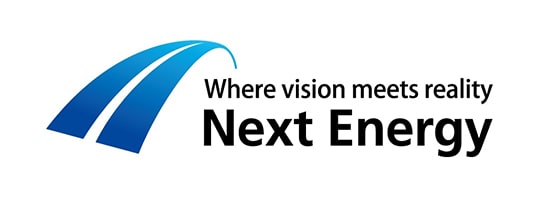
Expansion of renewable energy&Circular Economy through self-consumption PV System
The key for expanding renewable energy! Introduction of related products&services for self-consumption PV system
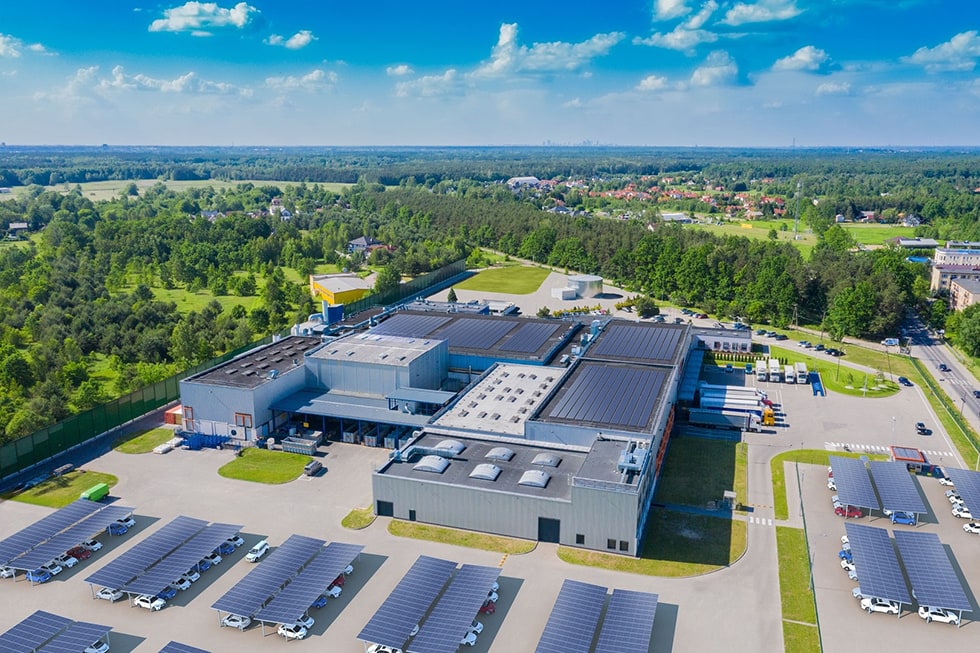
Image of solar power generation equipment installed on roofs and in parking spaces
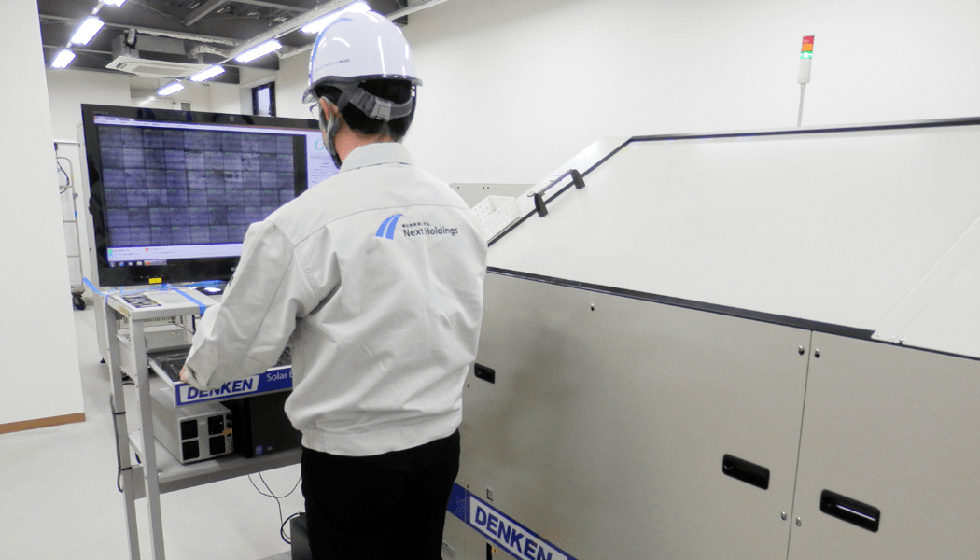
Inspection of used solar modules(By visualizing the infrared light emitted from the cells when current is passed through the solar cell module, cracks in the cells and wiring abnormalities can be checked.)
We believe "self-consumption PV system" is the most effective way to resolve climate change which enables the rapid implementation of renewable energy. The self-consumption PV system stands for self-production and self-consumption of electricity by installing PV system at residence or at the company's facilities for using the generated electricity by themselves.
We are actively developing products and services for self-consumption PV system focusing on “Competitive”, “Rapid”, “Bulky” and “Flexible”.
Since 2005, we have considered mass disposal of PV modules as an issue, and offering solution.By using our knowledge and data gained through inspection of used modules exceeding 140,000 units, we are working for establishing appropriate recycling product cycle.
Display the document

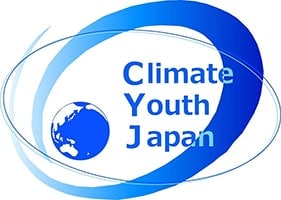
The Sustainability of Tokyo 2020 Games ~the Expectations for Osaka Expo 2025~
Learning from the unsustainable aspects of the Tokyo 2020 Games, and propse to hosting a sustainable Osaka Expo 2025
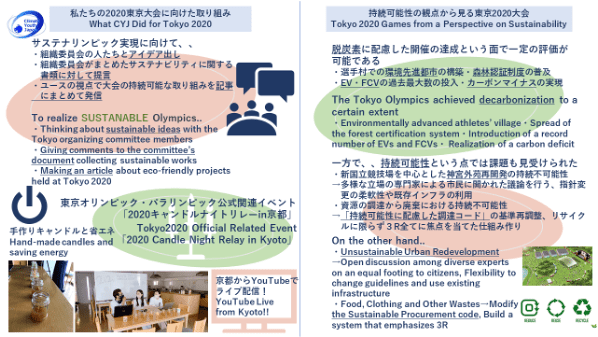
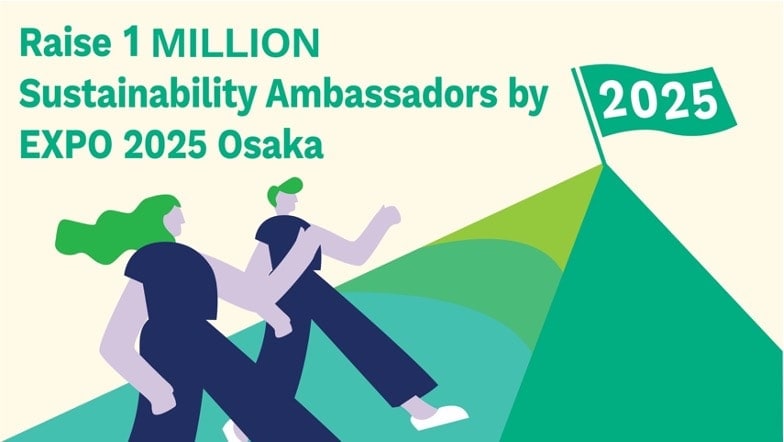
The Tokyo Games achieved decarbonization through the creation of an environmentally advanced athletes’ village, the spread of the forest certification system, the introduction of EVs and FCVs, and the realization of a carbon deficit. Whereas, there are issue of the overdevelopment, food and clothing loss, the carbon offsetting etc. The Osaka Expo also has the sustainable issues such as the biodiversity, the conservation of endangered species and the use of facilities after the Games. In addition, the basic plan only mentions existing technologies such as ESMS and the use of renewable energy, and does not reflect the Tokyo Sustainalympics. Therefore, it is necessary to use advanced transportation systems and other technologies to address environmental concerns in Osaka Expo.
Display the document



